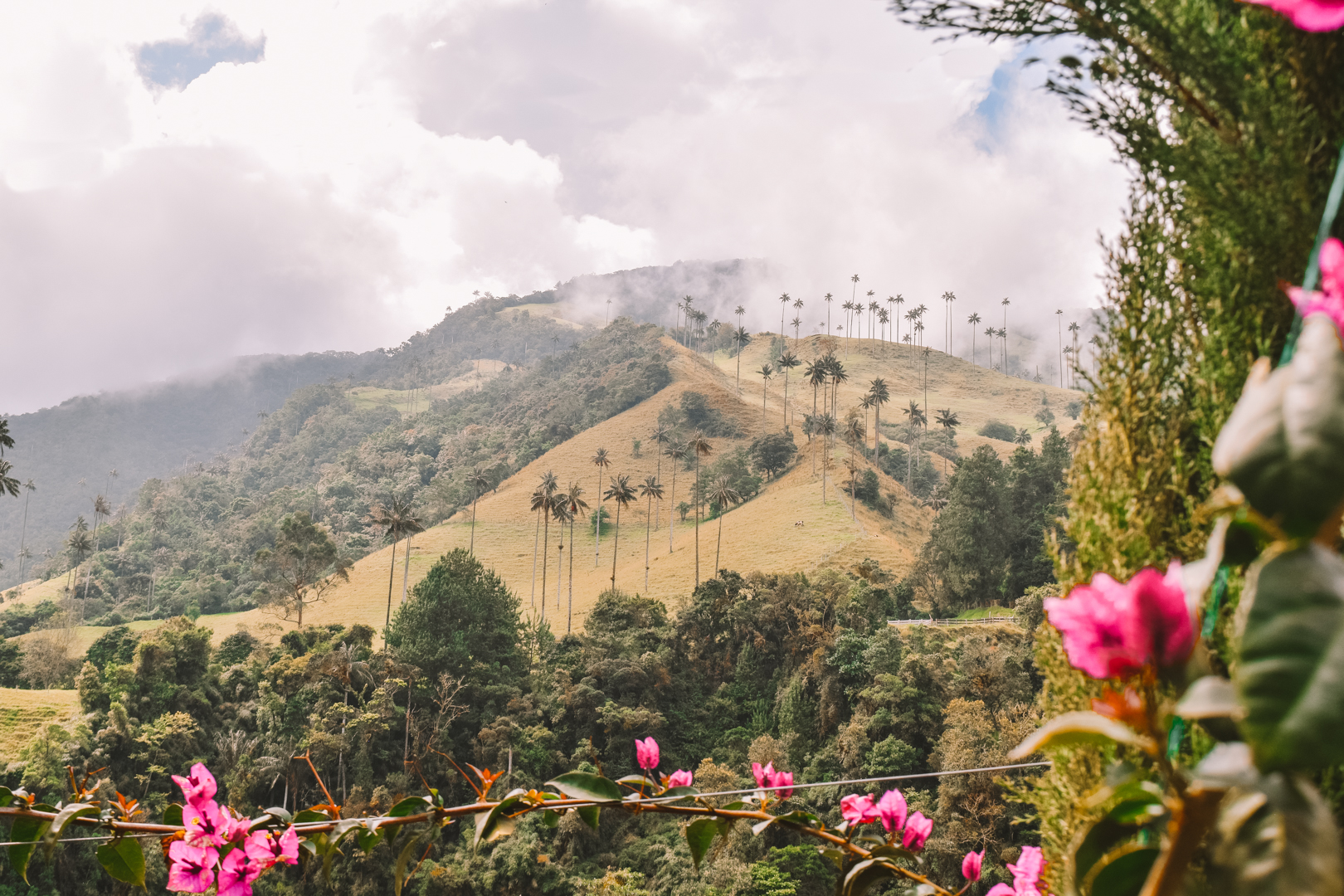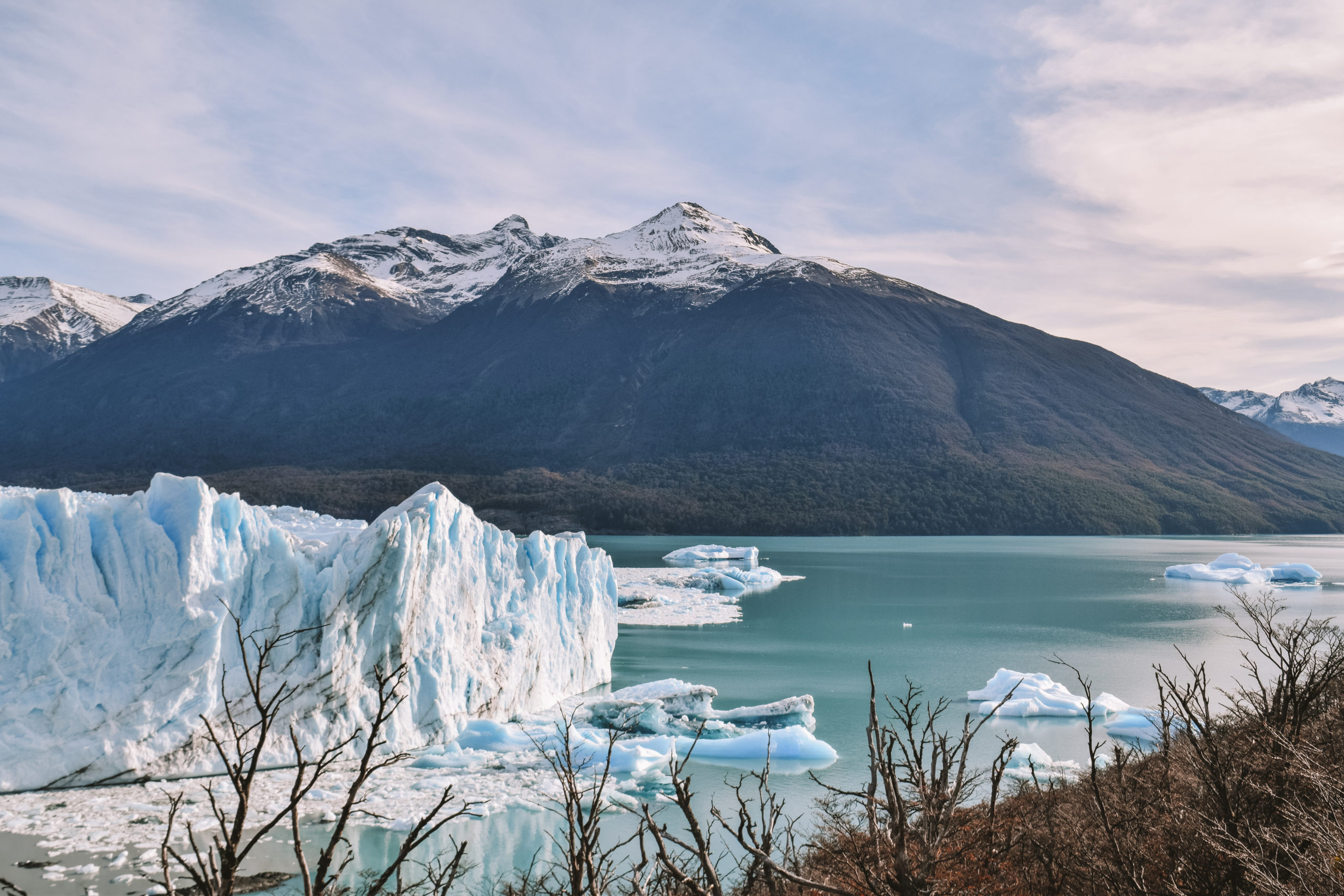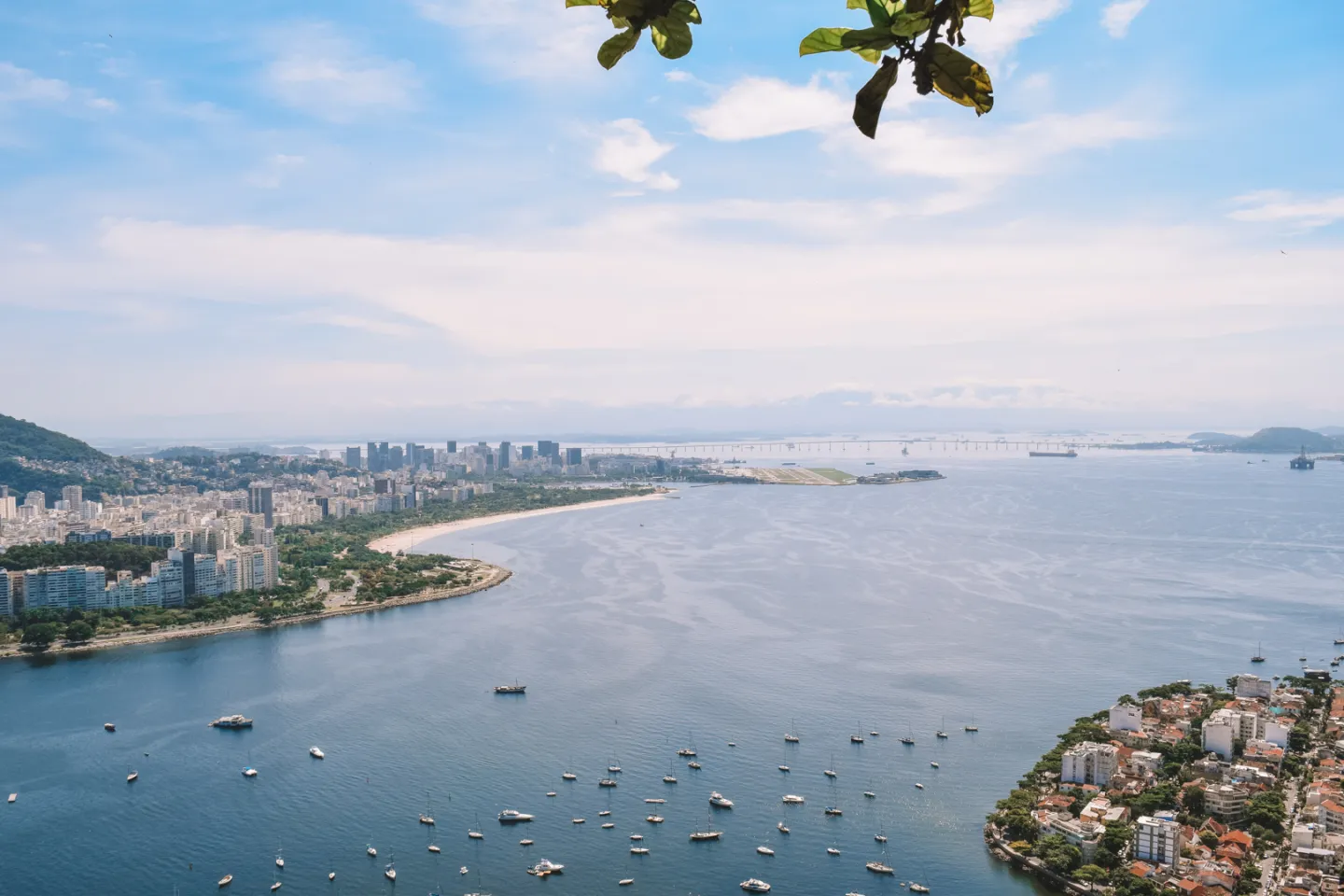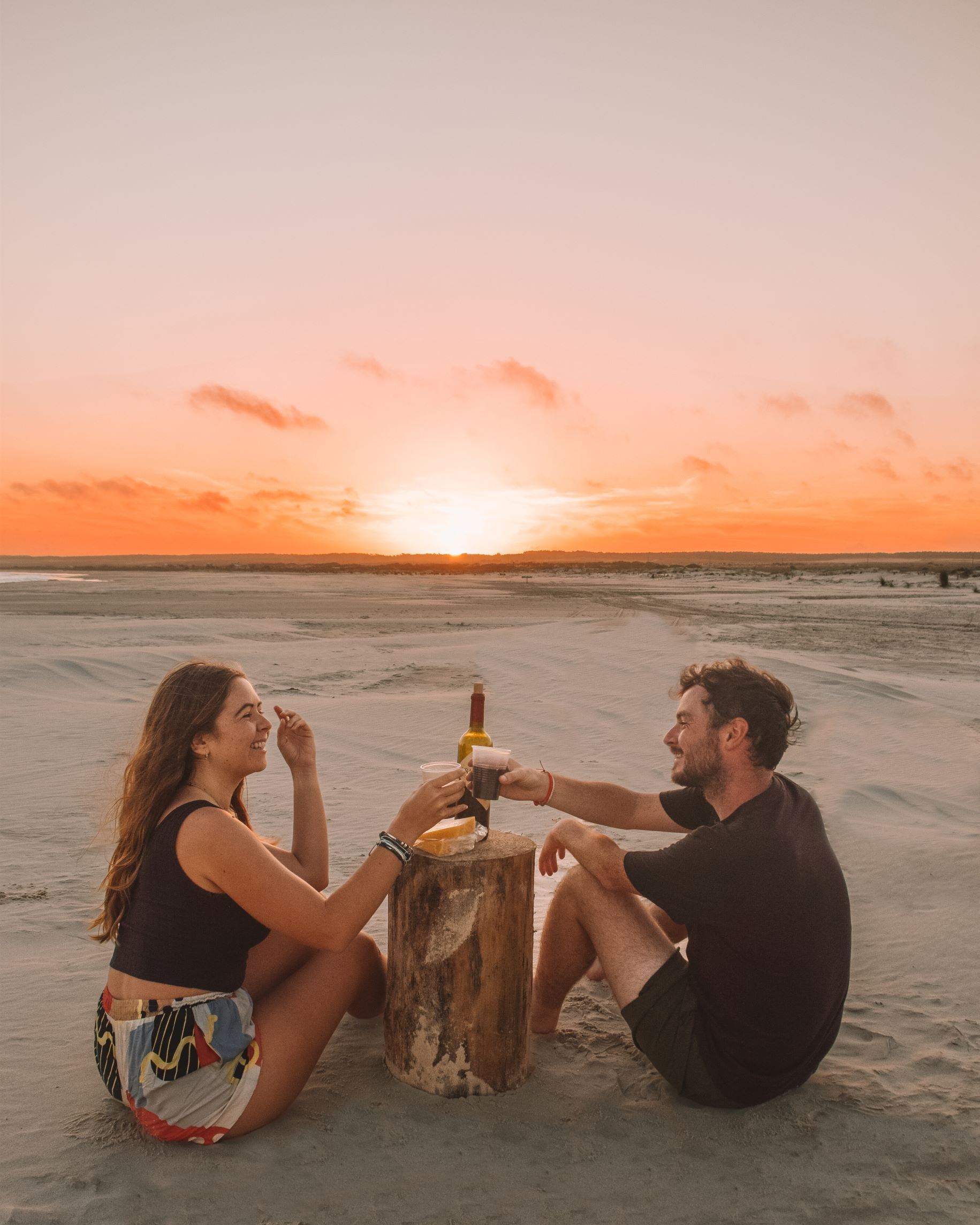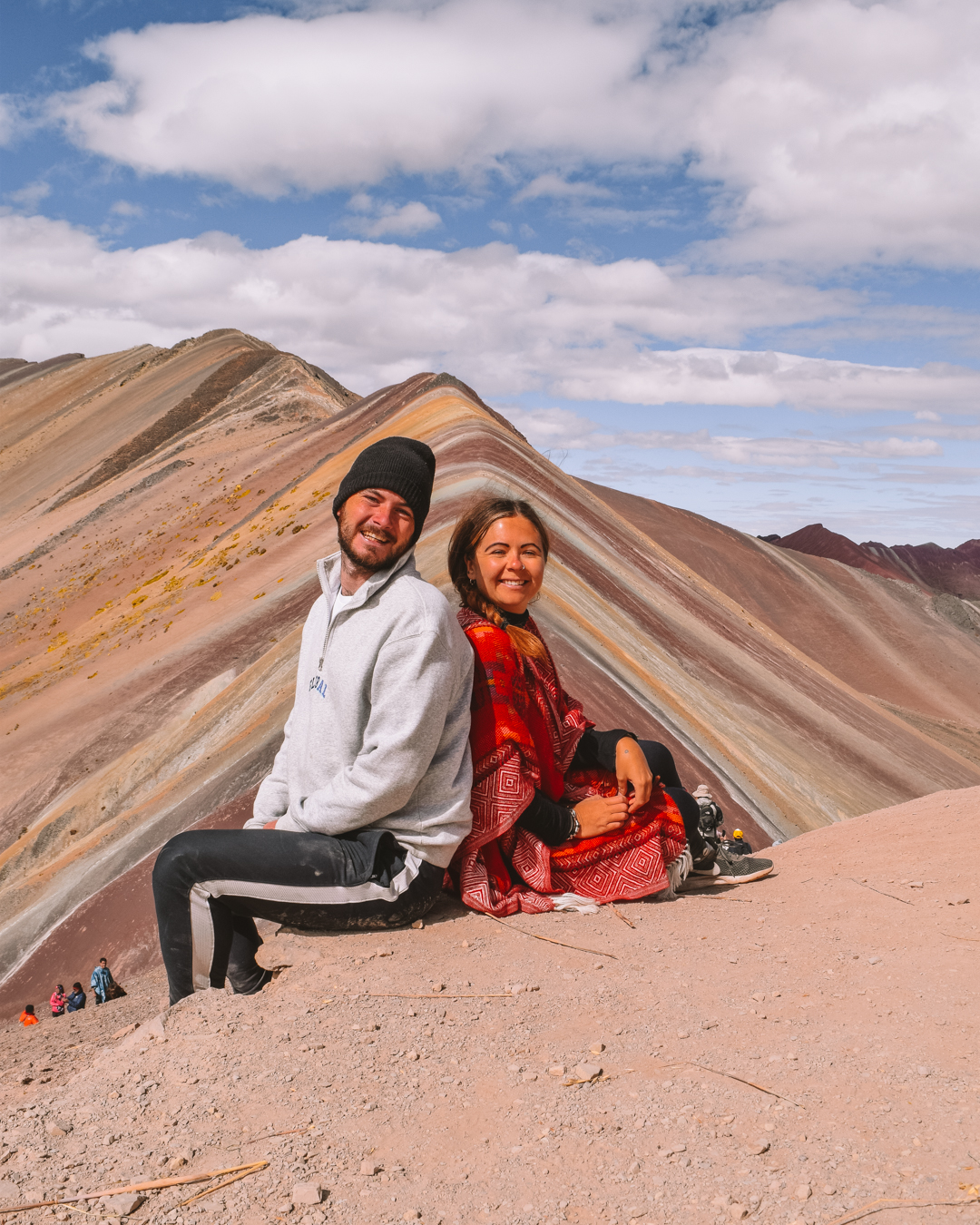Colombia: the Ultimate Travel Guide
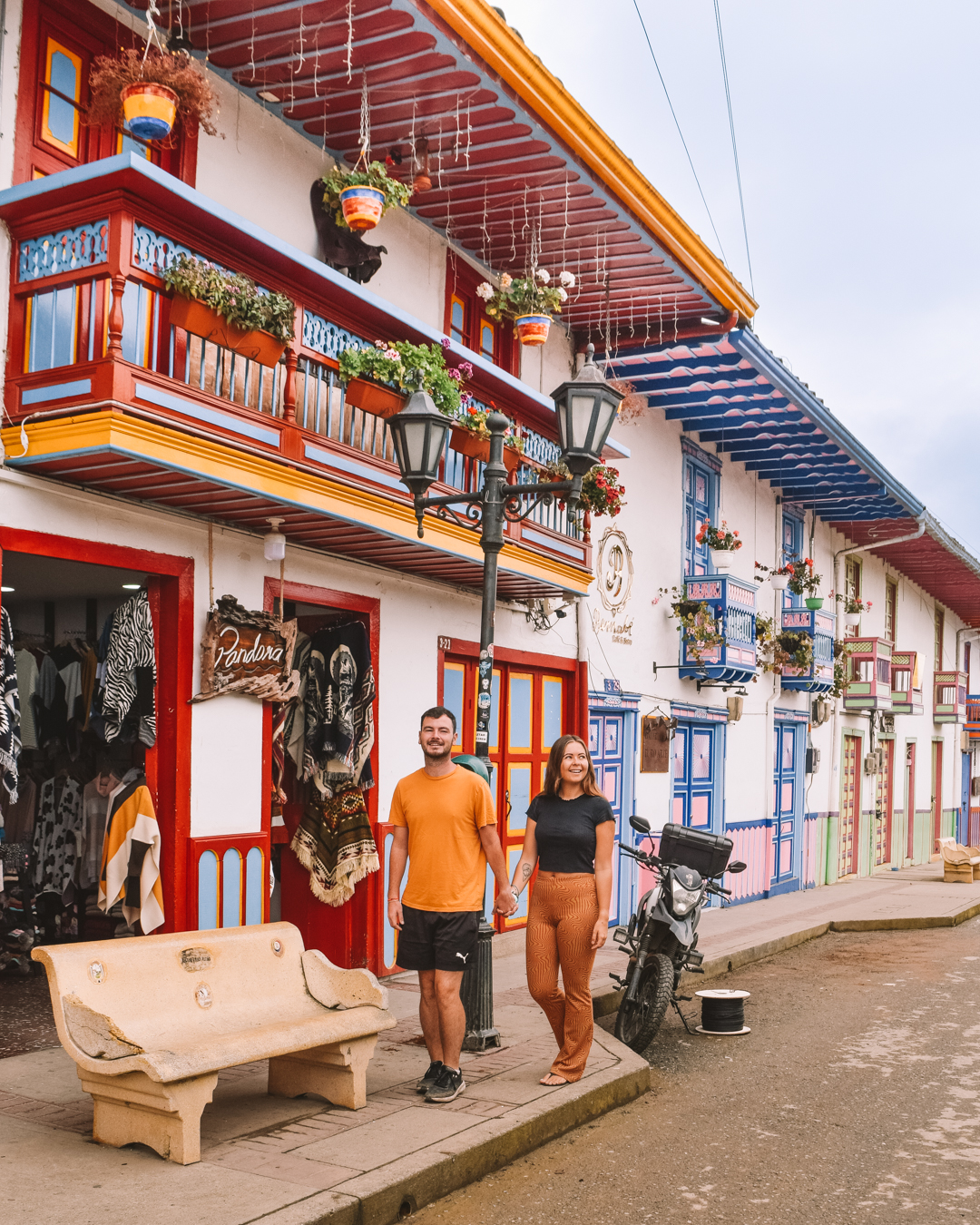
So, you’re thinking of travelling to Colombia? Excellent decision! Read on for our best places to visit in Colombia, top places to stay in Colombia and top tips for planning your travel visit to Colombia.
Colombia is fast becoming the highlight of most people’s trips to South America. After decades of struggling with crime and cartels, Colombia has now become a hub for digital nomads and budget backpackers alike. More and more people are flocking to the country to see what all of the hype is about, soak up the colourful atmosphere and explore all of the epic places that Colombia has to offer. Wherever you go you’ll find travellers raving about the beaches, the transforming cities, the boom of creativity and the warm welcome received from people proud to show off what has hidden away for so long. It’s no wonder more and more people are opting to travel to Colombia.
If you’re travelling South America then you should also read Ecuador Travel Guide: 10 Days Spent In Mainland Ecuador.
Changes to travelling to Colombia
From a country that was heavily advised against travelling to for years and in the headlines for all of the wrong reasons. Colombia has quickly surpassed being a secret, word-of-mouth destination for those travelling around South America, to become one of its most talked about destinations. The country’s position as a safe country for travel has now spread at rapid speed through the backpacker community. Making it one of the most popular destinations in South America alongside its neighbours Brazil and Peru.
The colourful country has so many incredible spots to travel around from the lively cities to the world-class beaches and National Parks to the unique towns like Guatepae.
We spent 3 weeks travelling around Colombia at a fairly fast pace and still only feel like we scratched the surface. It’s one of those countries that we could easily go back to and spend months in, seeing completely different places every day. Travelling to Colombia is certainly a bucket list experience!
This comprehensive travel guide on travelling to Colombia gives you all the tips, tricks, and travel hacks you need to be able to plan your dream trip travelling Colombia.
Total time spent here: 3 weeks
Budget: We spent roughly £30 each per day whilst we were in Colombia
Colombia travel facts:
The language that is spoken in Colombia: The main language of Colombia is Spanish.
The official unit of currency of Colombia: Colombian Peso
Size of Colombia: 1.134 million km² (440,000 sq. mi)
Capital of Colombia: Bogotá
Transportation used when travelling around Colombia: As with most countries in South America, buses are the main mode of transport in Colombia. Most towns have a central bus station from which large public buses depart for destinations across the country. We used a combination of buses, including overnight buses.
Visa and entry requirements for Colombia: Visitors from most countries do not need a visa for a visit of up to 90 days. However, you must have a valid passport with up to 6 months of validity. You must also hold proof of onward/return flights.
Our Travel Route around Colombia:
- Capurganá
(This was due to us entering from San Blas Islands. You can read all about our trip around San Blas here.) - Cartagena
- Casa en el Agua/ San Bernardo Islands
- Back to Cartagena
- Medellín & Guatapé day trip
- Bogota & Salt Cathedral day trip
- Salento & Valle del Cocora day trip
- Cali
- Ipiales & Catedral Las Lajas day trip
Capurganá
If you opt to go on a San Blas tour then there is a high chance that you will begin your journey around Colombia in the little sleepy border town of Capurganá. With the Darien rainforest to the north and Colombia’s Caribbean coast to the east, Capurganá is the most isolated place that we visited in the whole of Colombia.
This region of Colombia was inhabited by the Cuna Indians and the name Capurganá translates to the “land of chili’. Nowadays, it’s a lad back town with no cars, hikes for days and altogether a completely different way of life to anywhere we had experienced thus far on our travels around Central America.
This is where we received the Colombian stamp on our passports and where we officially entered Colombia. As if to truly back up just how laid back this spot is, the immigration officer was casually sipping on a beer as he stamped our passports into this new and exciting country.
*Make sure that you take enough money with you to Capurgana when you’re travelling to Colombia. Unless you hold a Bancolombia card, there is NO way to withdraw money once you are there and most places don’t accept cards. We did find a few restaurants that were exchanging other currencies for Colombian Pesos. However, these were at an awful exchange rate and should only be used if you have no other option!
Where did we stay in Capurganá?
There are not many places to stay in Capurgana varying from very laid-back hostels to cute guesthouses. We opted for the latter in the shape of Los Robles Capurgana.
After 3 nights of sleeping in very basic accommodations with limited running water on the San Blas islands, this place felt like paradise. And quite frankly it wasn’t far off. Slightly out of the main town, down a dirt path lies this tropical haven. With hot running water, distant beach views, friendly staff and lush rainforest. We would highly recommend this spot if you’re visiting Capurgana, especially after a San Blas tour.
The rooms vary from $22 to $32 per night sleeping 2-4 people, this includes breakfast.
You can book a stay in Los Robles Capurgana here.
If you’re looking for a budget option and somewhere that is a bit more central Hostal Capurgana is a great option! Being on the main street it is an excellent choice! Clean and comfortable rooms, on-site wifi and a good restaurant.
You can book a stay in Hostal Capurganá here.
What are the top things to see in Capurganá?
We’ll be honest, after a hectic few weeks we didn’t actually do much in this sleepy town. So, our number one recommendation would be to go slow and enjoy the town itself!
We spent our days meandering along the dusty roads of the town itself and enjoying taking in the slower, more simplistic pace. Eating at the local restaurants and lazing in the hammock on our balcony.
If you’re looking for a more relaxed time, experiencing the local life then you can spend your time watching the men load up their trolleys at the dock, see fishermen bring back the day’s catch in their colourful boats, barefooted kids playing in the streets, women preparing their carts to sell street food to hungry locals and visitors and groups of men playing dominoes and trading stories over beer at plastic tables.
It really is a pretty unique experience.
If this doesn’t sound like your thing then there is an abundance of hikes in the surrounding areas that you can do. Including Sapzurro and Reserva Natural El Cielo.
Cartagena
One of the most popular spots in Colombia and our favourite city is Cartagena. A city which truly gets under your skin almost instantly. With its mix of old and new. Its crumbling walls of yellow, red, and blue, are perhaps some of the most photogenic that we saw in South America. Full of funky cocktail bars, colourful shops, beautiful sunset spots and cobbled streets. We almost instantly fell in love with the city. In our opinion, it is one of the best places to visit when .travelling to Colombia.
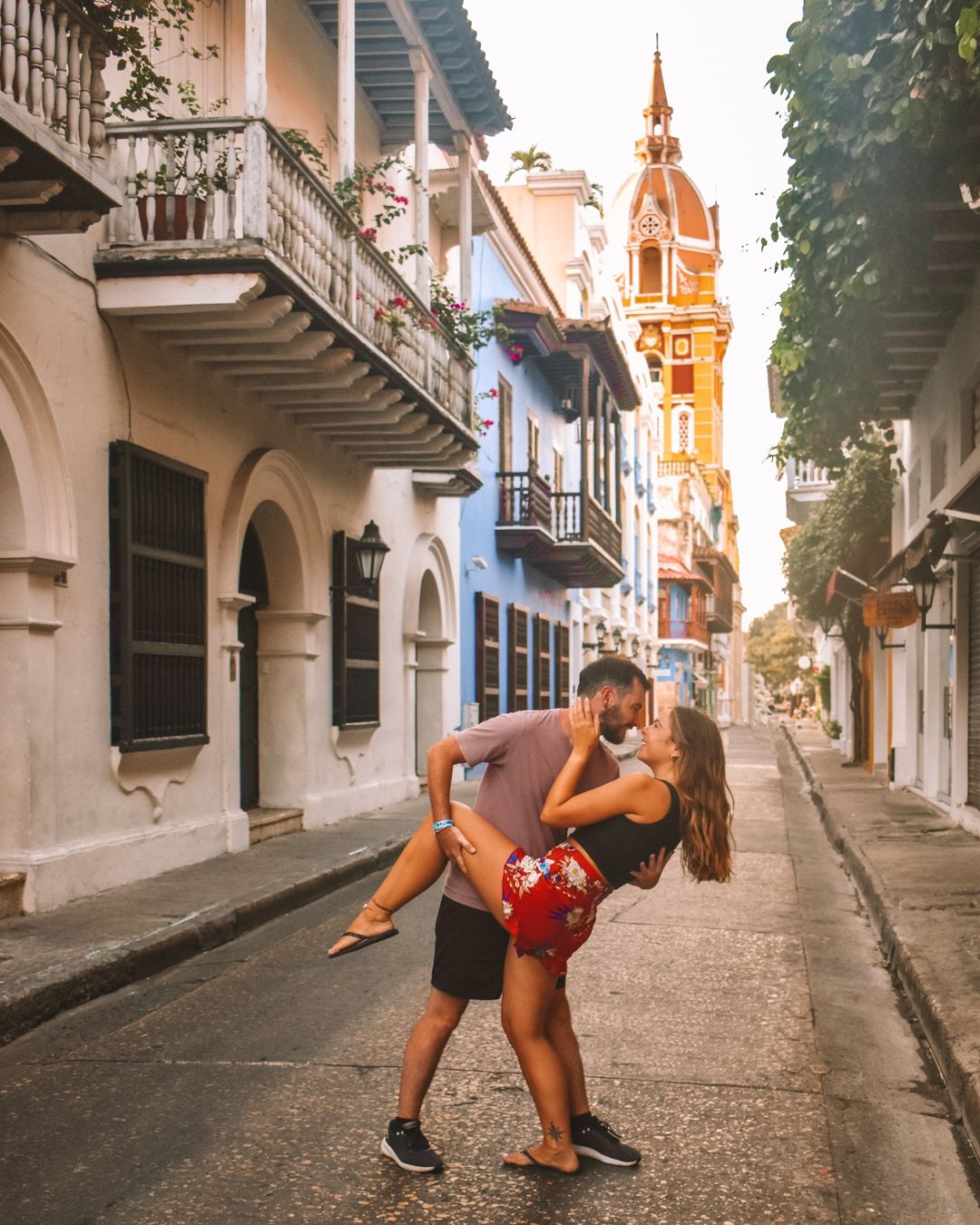
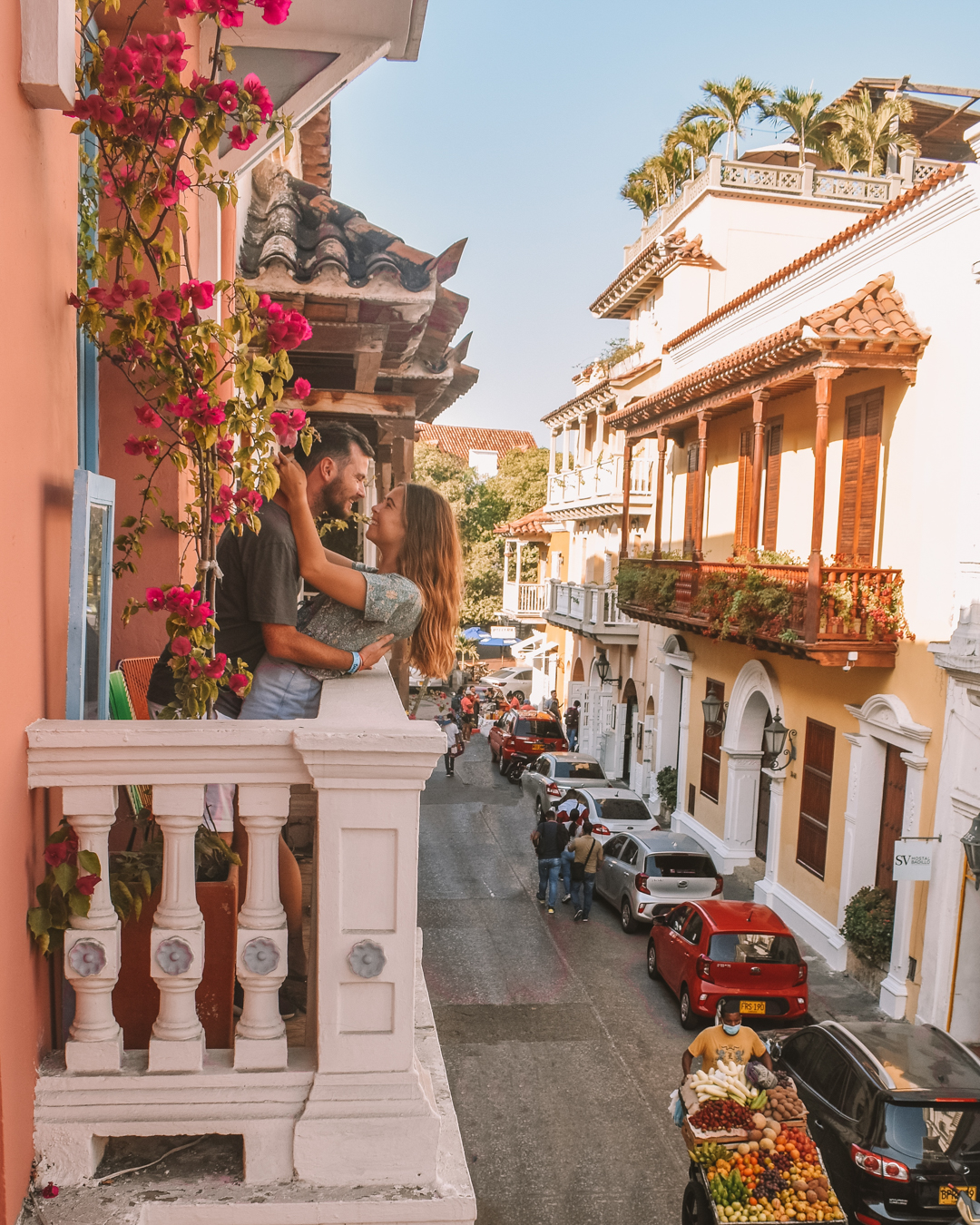
Where did we stay in Cartagena?
When it comes to choosing where to stay in Cartagena there are tons of choices all dotted around the city from backpacker hostels to beautiful hotels. These are the hostels that we recommend in Cartagena:
Republica Hostel Cartagena
This is where we stayed. We opted for dorm rooms here as we were also with Reanna’s sister and friend. It was a great hostel, with comfy beds with curtains for privacy, big spaces to relax and a cooked breakfast included. It’s also in a great location inside Cartagena Old Town.
You can book Republica Hostel Cartagena here.
Viajero Cartagena
A great option for solo backpackers and groups looking for good-value dorms in a social hostel.
You can book Viajero Cartagena here.
It doesn’t have many doubles, but it’s a great overall hostel with a guest kitchen and rooftop complete with two jacuzzis! This hostel has good value dorm beds too.
You can book Life Is Good Hostel here.
What are the top things to see in Cartagena?
Cartagena doesn’t have a huge deal of attractions per se but, the beautiful streets of Cartagena’s old town and the quirky ones of Getsemaní more than made up for this! Here is our list of must-see spots to visit in Cartagena when travelling to Colombia:
- Explore the streets and restaurants of Getsemaní
- Marvel at the street art
- Walk around Cartagena’s old town
- Take a day trip to the islands (more on this later)
- Watch the sunset from either Cafe del Mar (Google Maps) or from the old wall ramparts on either side of Cafe del Mar (just make sure you arrive early to get a spot!)
A full blog post on vising Cartagena coming soon!
Casa en el Agua/ San Bernardo Islands
The San Bernardo Islands are a set of pristine white islands located just off the coast of Cartagena dotted in the Caribbean ocean. They make for a wonderful trip to get your dose of Vitamin D and Casa en el Aqua, otherwise known as the house on the water, is the perfect place to do this.
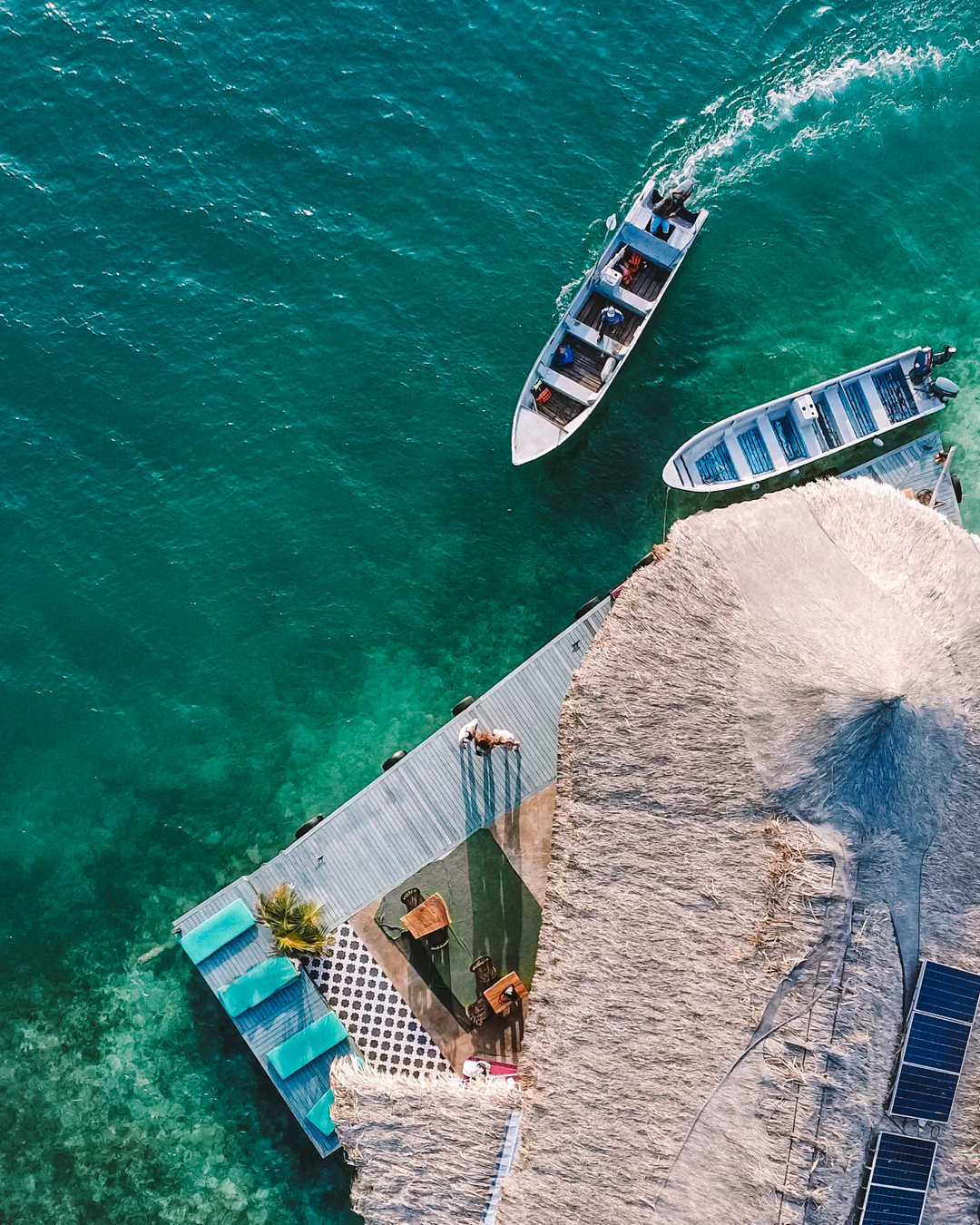
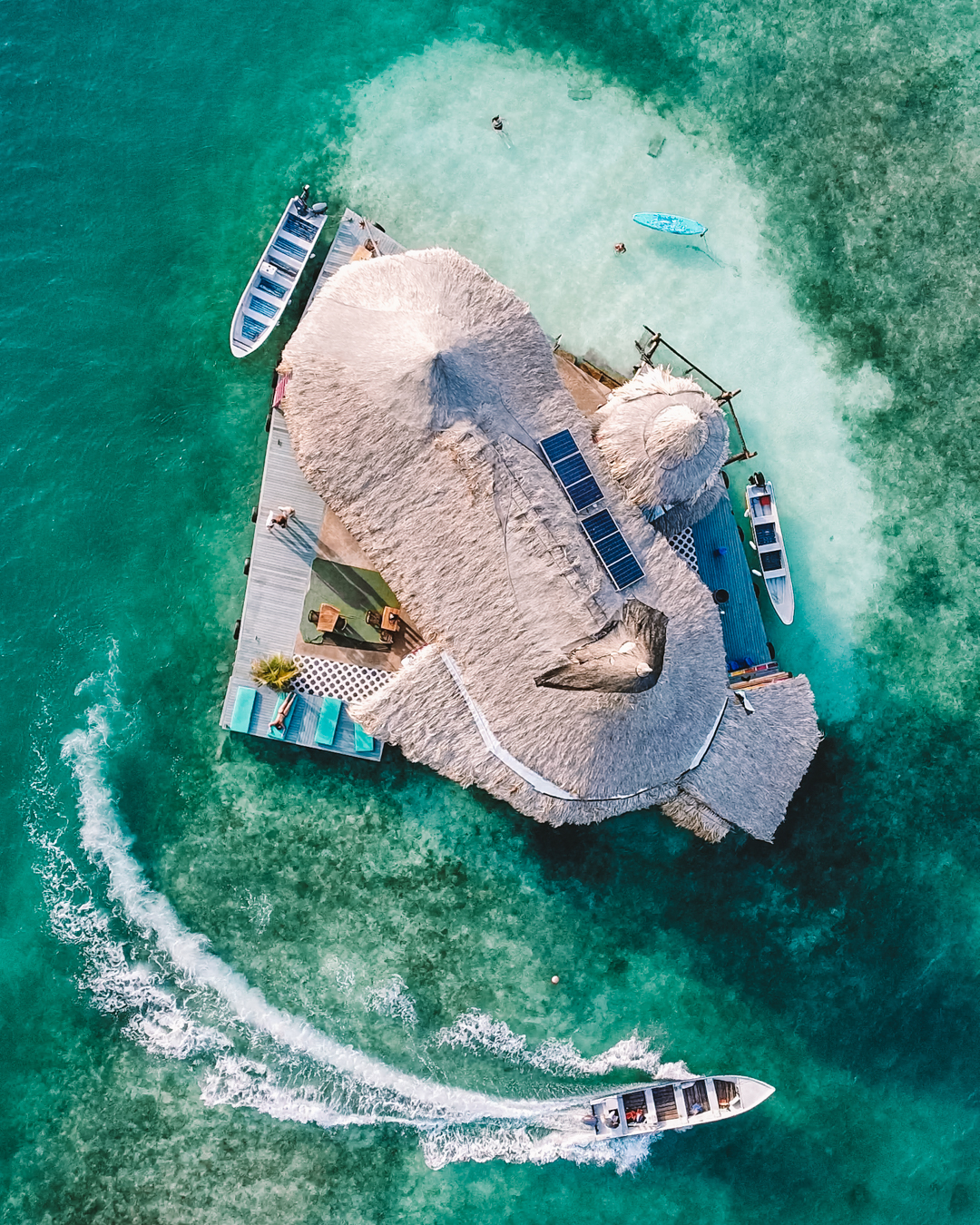
Where did we stay?
This one is pretty self-explanatory. Whilst there are quite a few different islands you can stay on, the infamous Casa en el Aqua translating to House on the water drew us in.
Casa en el Aqua is an entirely unique eco hostel which, as you guessed it, sits above the water. You can book a range of rooms varying in cost. We paid £80 per night in one of their mid-luxury rooms with a beautiful sea view. Due to the nature of the hostel, each room comes with 3 meals per day, free coffee, tea and water. You can also buy alcoholic drinks at the bar or snacks in the hostel.
You can read all about our time in Casa en el Aqua/ House on the water here.
Medellín & Guatapé
Medellín is the second-largest city in Colombia, after Bogotá and the one that has transformed itself perhaps more than any other city in the world. Though well known for its violent, tumultuous past, today the city is modern, innovative, and thriving in the art and technology sectors.
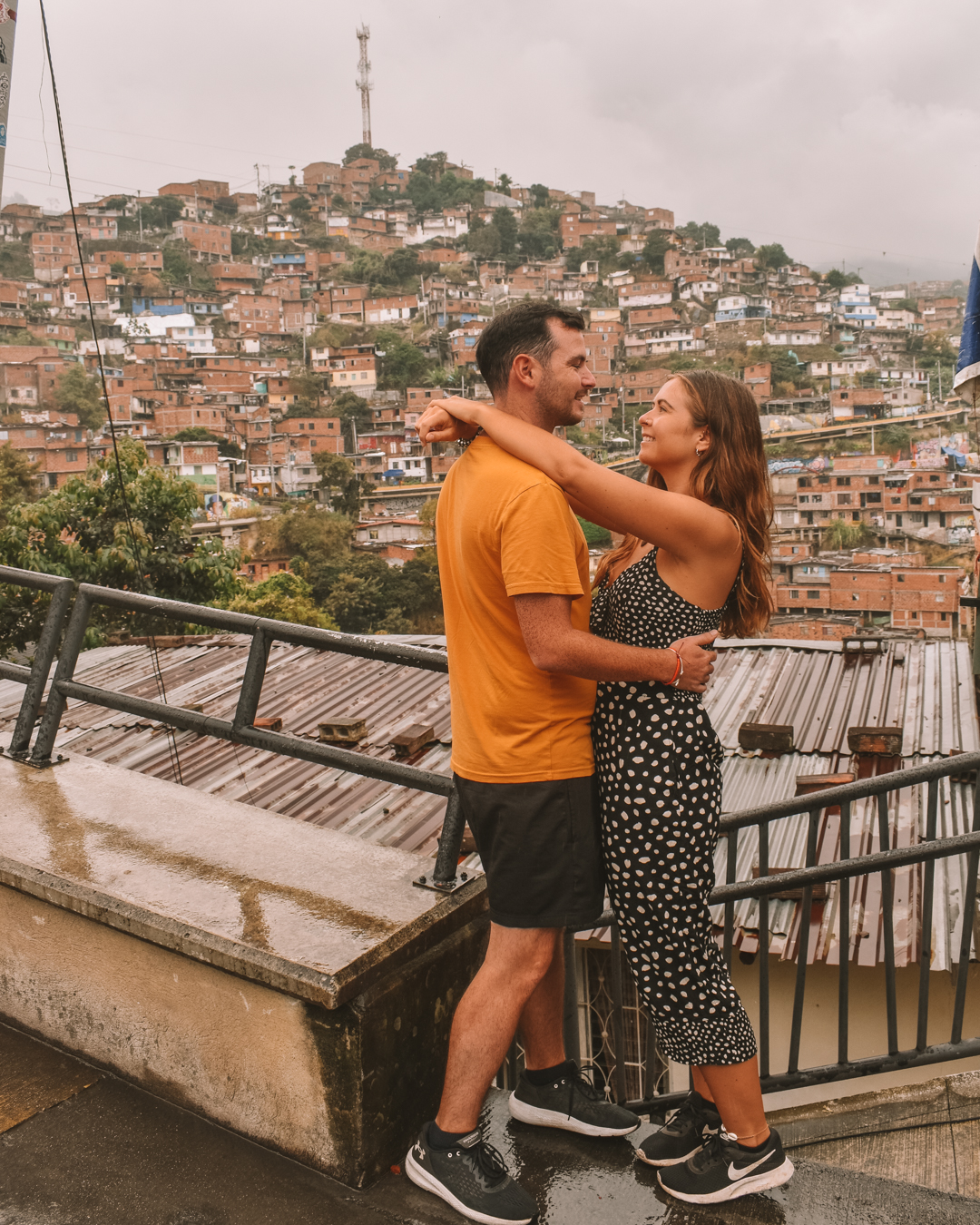
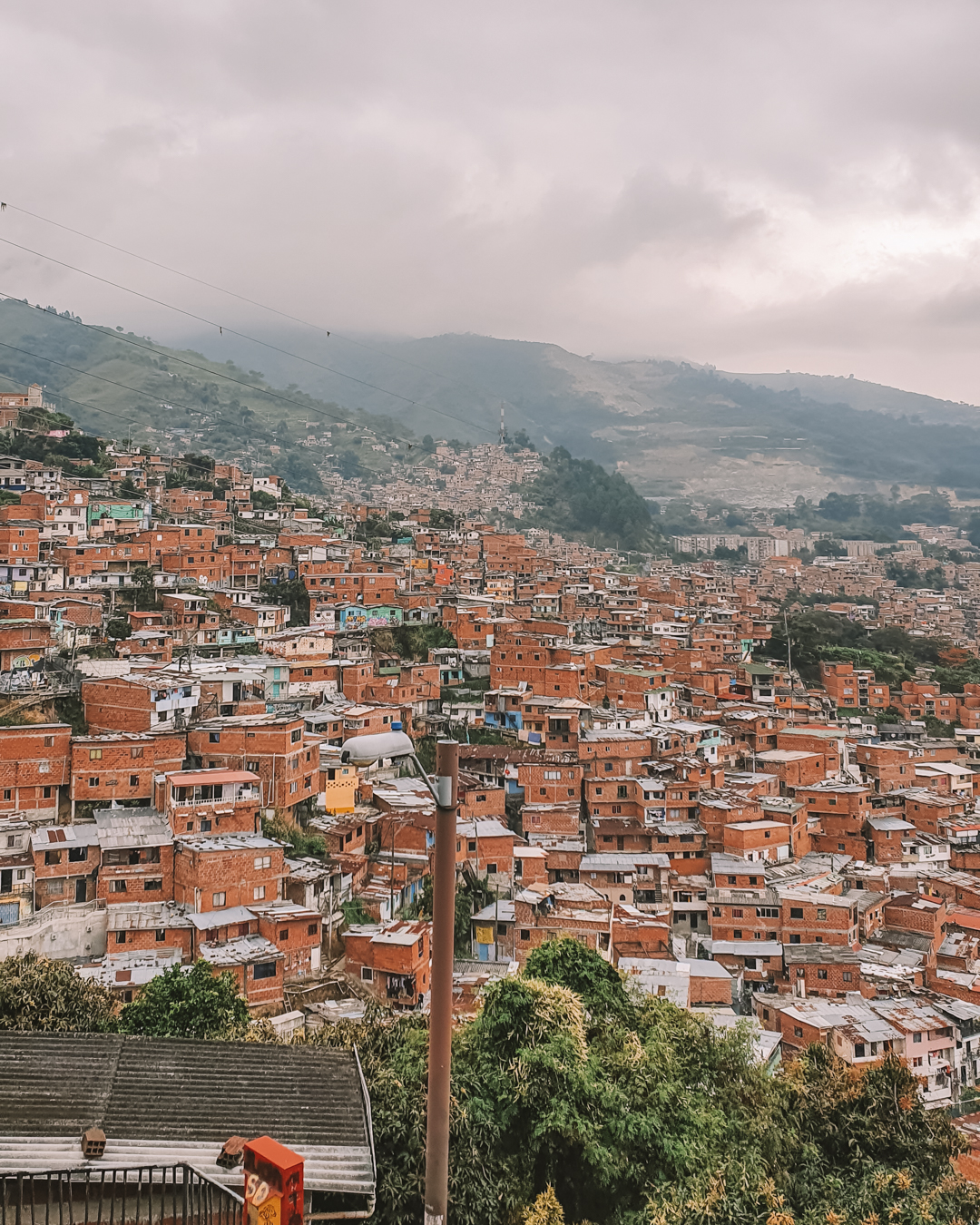
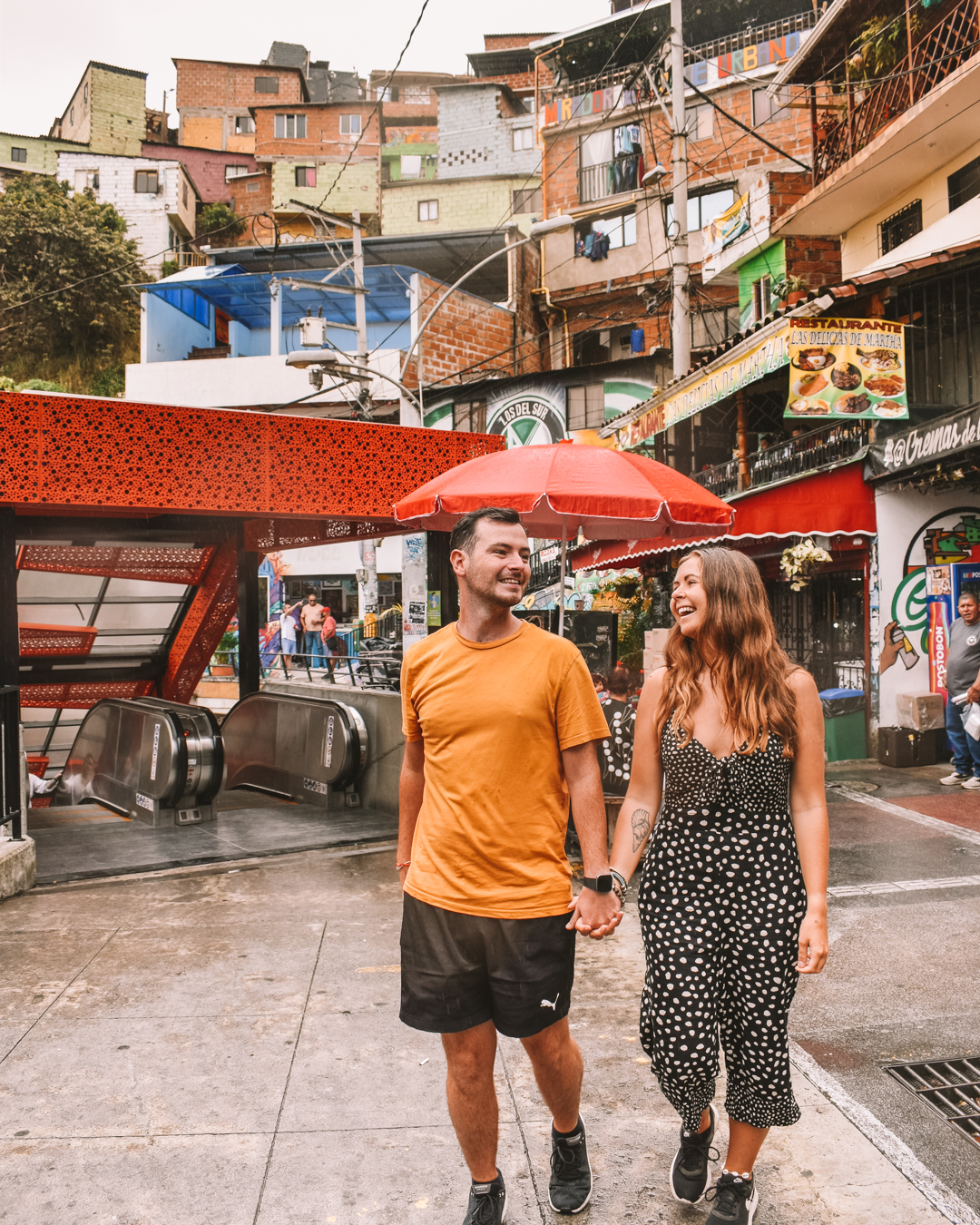
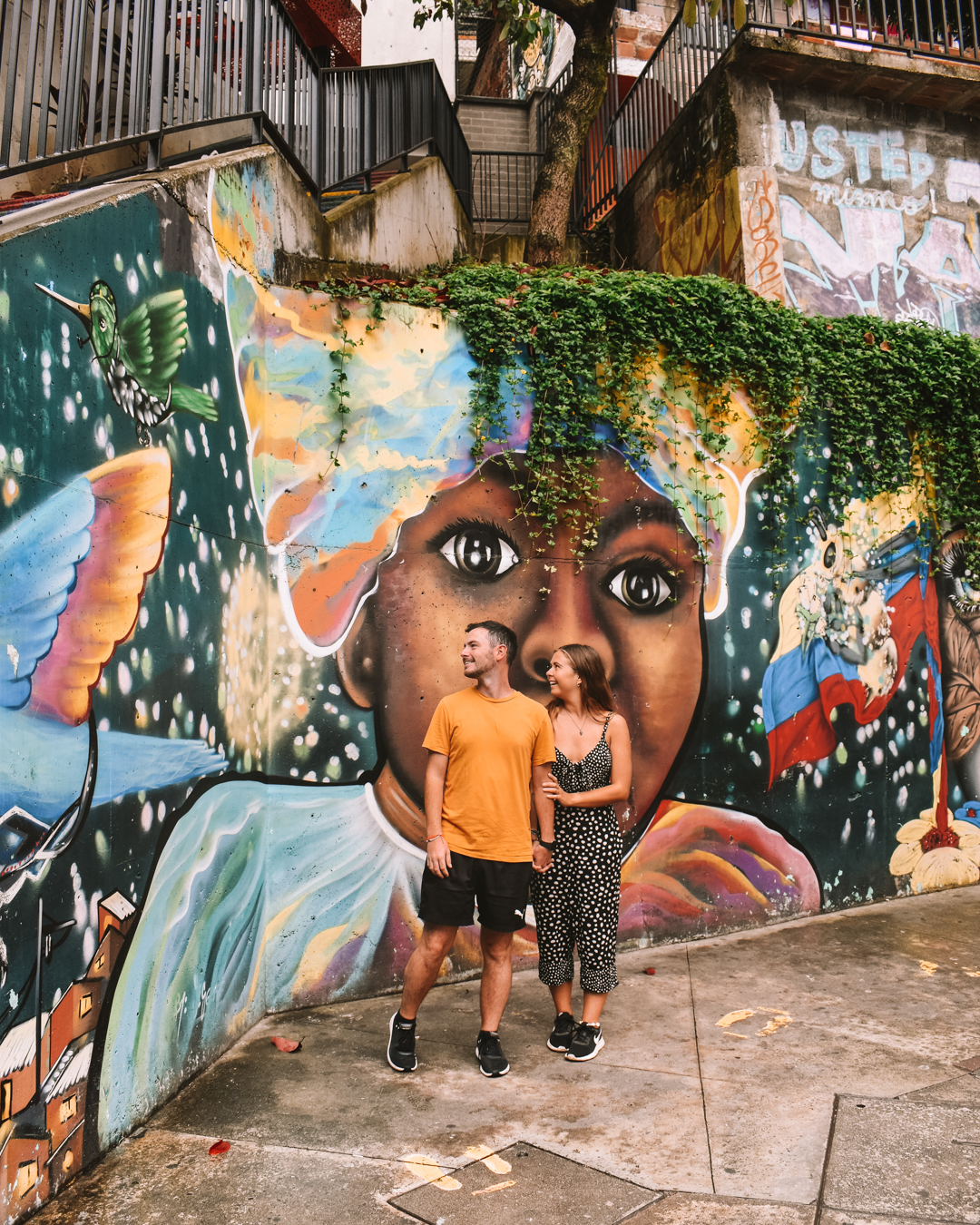
Prior to visiting it really helps to learn all about the city’s past in order to appreciate how far it has truly come. From drug lord: Pablo Escobar to Comuna 13; considered one of the most dangerous neighbourhoods in the world, the city really has seen its fair share of adversity. Now, there are plenty of museums and tours that can educate you on its history, along with authentic markets and neighbourhoods to explore. The city is also home to great restaurants, cafes, bars, and even clubs that’ll have you salsa dancing the night away.
Guatapé
A stone’s throw away from Medellin, Colombia, lies one of the most colourful little villages you’ll ever come across; the town of Guatapé! Surrounded by beautiful lakes, this tiny town is an incredible day trip from Medellin not to be missed. Stroll through the rainbow-coloured alleyways, take a trip out on the lake or admire the stunning views from La Piedra del Peñol, a 65-million-year-old climbable rock. We absolutely loved our day here and wished that we had booked to stay overnight – we really didn’t want to leave! It definitely stole our hearts and is one of the best places to visit in Colombia.

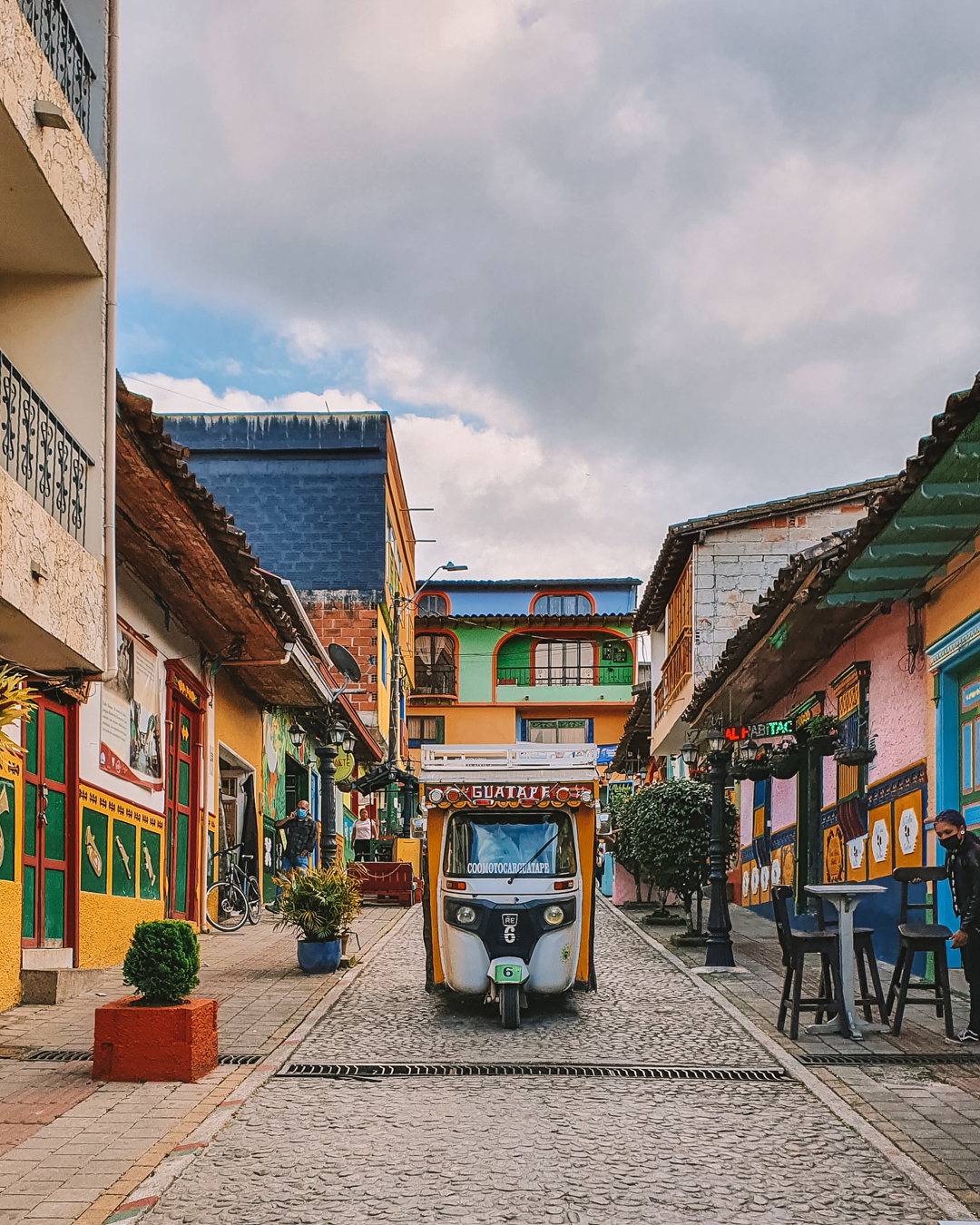
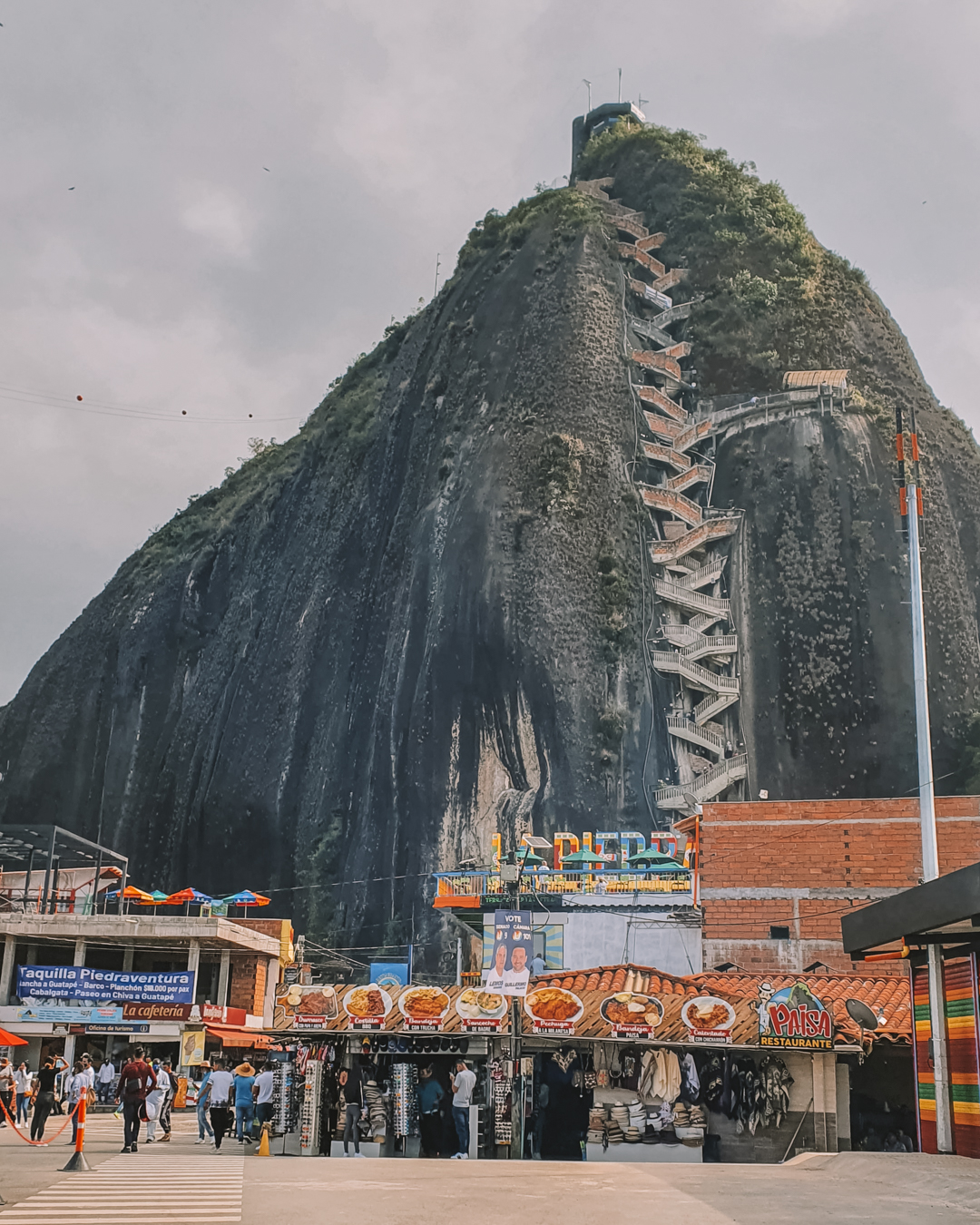
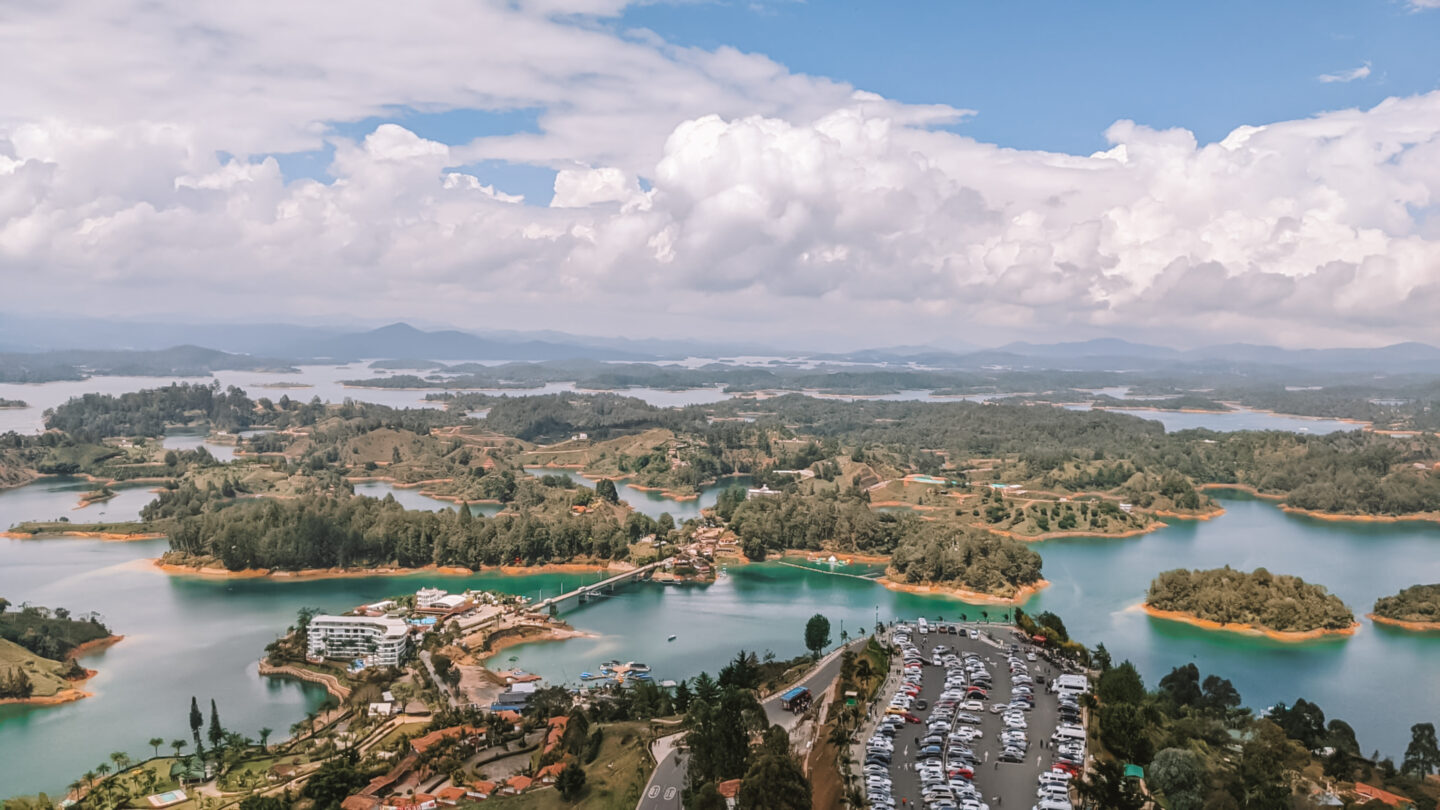
Unfortunately, our hearts weren’t the only thing that was stolen on this trip. Our camera was also stolen (more on that later) with our photos from Guatapé on, so we don’t have many. But, that just means we’ll have to return one day!
What are the top things to see in Medellín?
There is plenty to keep you entertained during your time in Medellín. Whether you’re looking for history, epic day trips or an amazing place to eat. A trip to Medellín will be sure to satisfy all this and more!
Our top things to see in Medellín are:
- A walking tour around Comuna 13
- Take a day trip to Guatapé (one of the highlights of our time in Colombia)
- Ride the iconic Metrocable (cable car system)
- Visit Plaza Botero in Medellin’s historic Old Quarter
- Take a free walking tour of the city
- Visit Casa Museo Pablo Escobar (this one is controversial so do your own research prior to visiting)
Where did we stay in Medellín?
Medellin is no exception to the ‘Colombia has the best hostels rule’ and blew us away with its incredible variety, things like this make travel to Colombia a breeze. A few hostels that we would recommend include:
Hostel Rango Boutique
Both hostels have incredible facilities ranging from rooftop pools to jacuzzis to games rooms, hang-out areas and coworking spaces. Both hostels have dorm rooms that start from £15 and £14 respectively.
You can book a stay in Hostel Rango Boutique here.
You can book a stay in Viajero Medellin Hostel here.
Travelling to Colombia
Bogota
Bogotá is Colombia’s huge, high-altitude capital. It’s packed full of restaurants; old and new, shops and beautiful cobbled streets. It’s a perfect juxtaposition between old and new. Bursting with vibrant street art, an incredible historical centre and delicious food it’s an epic city. Bogota is filled with gritty streets and glass skyscrapers mixed in with pretty colonial buildings.
Unfortunately, our time in Colombia’s capital city was tarnished as our camera was stolen on our first day here. We chose to have lunch in Puerta Falsa with Reanna’s sister and friend. Right from under all of our feet, our camera was stolen. These people are professionals so be as vigilant as possible. Unfortunately, that meant that all of our photos prior to this were stolen. This a reminder to back your photos up regularly!
What are the top things to see in Bogota?
- Visit Iconic Plaza Bolivar
- Hike Cerro Monserrate
- Visit La Candelaria the beautiful Colonial area
- Salt Cathedral, Zipaquira (a day trip from Bogota)
- Eat in Puerta Falsa, a cafe which is over 2 centuries old
Travelling to Colombia?
Where did we stay in Bogota?
Bogota has some of the nicest hostels that we have ever experienced but, also some of the worst so be sure to read reviews prior to booking your choice of accommodation.
Spotty Bogota Centro
If we can call it a hostel, then Spotty Bogota is without a doubt the best hostel we have ever stayed in.
It has a rooftop pool, a gym, a restaurant/ cafe, a games room and a communal kitchen. As a couple, it wasn’t much more for us to stay in a private room so we opted to stay in a Deluxe Double Room with Private Ensuite which cost £25 per night, an absolute steal! Reanna’s sister and friend were also with us and stayed in a dorm room which cost £9 per night. This was after experiencing a couple of other not-so-impressive hostels first.
You can book to stay in Spotty Bogota Centro here.
Viajero Bogota Hostel & Spa
If you don’t fancy staying in Spotty then the other hostel that we were debating between was Viajero Bogota Hostel & Spa. This hostel in Colombia also looks incredible and has amazing reviews.
A Standard Double Bed Private Ensuite costs £32.39 so a little more, but the hostel does have a spa and is once again far more like a hotel than a hostel. A dorm room costs £10 so not too much more.
You can book to stay in Viajero Bogota Hostel & Spa here.
Salento
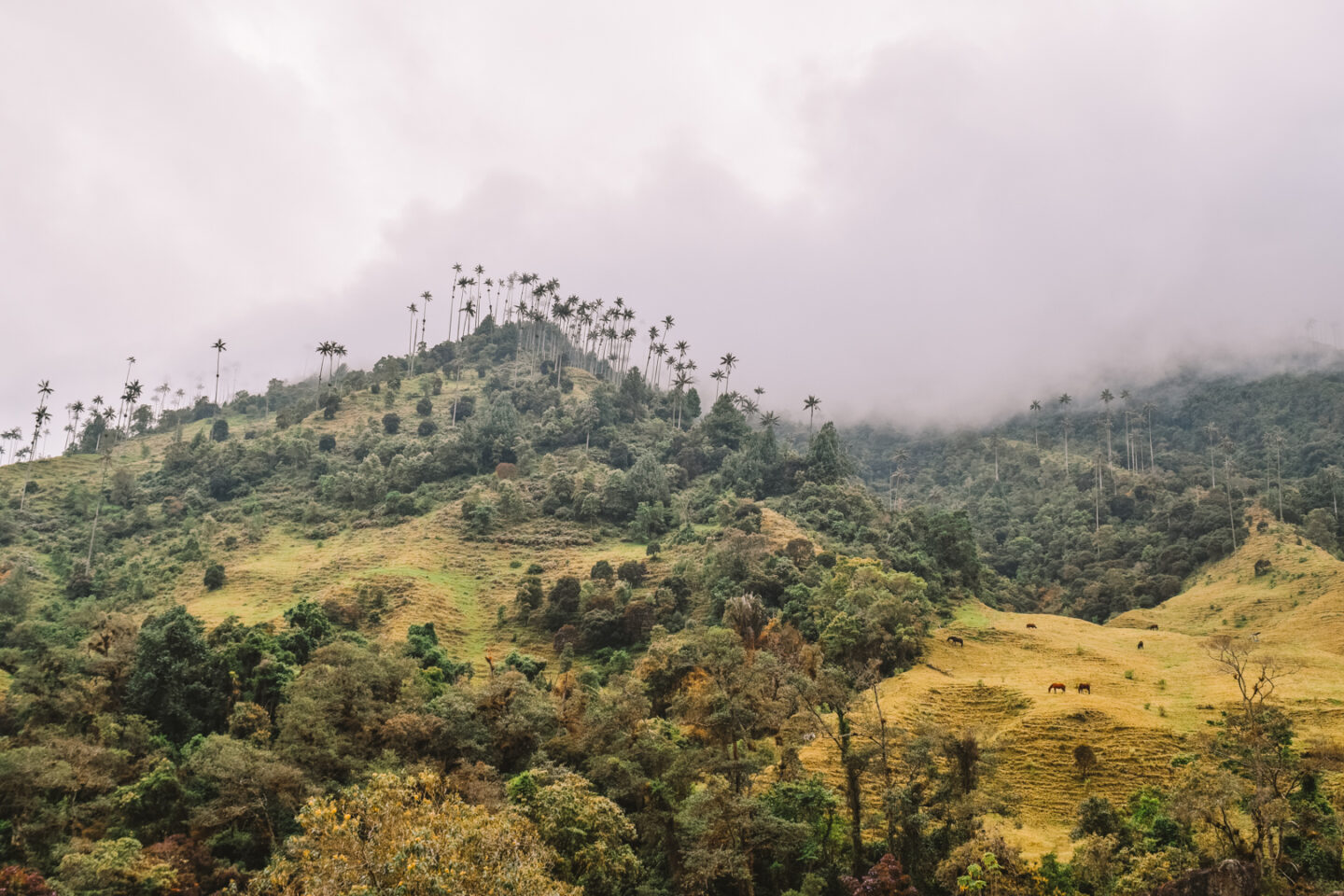
Beautiful Salento is a tiny colourful town located in the middle of Colombian coffee farms and the vast wilderness. A town of many colours and backed by one of the most mesmerising landscapes we’ve ever seen: the Cocora Valley. Home to the world’s tallest palm trees. We absolutely loved this little town and would highly recommend spending at least 2 nights here giving you enough time to enjoy everything that the town has to offer, as well as the nearby Cocora Valley. Salento possibly takes first place on our ‘best places to visit in Colombia’ list and is certainly a must-see when travelling to Colombia.
What are the top things to see in Salento?
The Cocora Valley
If you’re planning a trip to Colombia then the chances are that you’ll probably see these incredibly tall and skinny, wax palm trees mentioned in one of the guides, native only to Colombia and northern Peru.
You’ll find the palms located in the Cocora Valley, about a 30-minute drive away from Salento. The easiest way to get here is to hop in a colourful jeep from the main square, costing 4000 COP (approx £0.70) each way. This will take you to the entrance of the palm trees. From here, we decided to hike the entire trail (approximately 4-5 hours long) anti-clockwise so that we were rewarded with incredible views at the end of our trail instead of the beginning.
To do this, when you’re dropped off, turn left down a mud trail instead of going straight on. There are 2 entrance fees for the longer trail, one at 5000 COP and one at 6000 COP (approx £0.88-£1 in total).
If you don’t fancy a long hike then you can opt to just see the palms, this trail takes you around 1 hour. The longer hike takes you across multiple bridges, lakes and beautiful lush vegetation. It also gets super muddy, so be prepared!
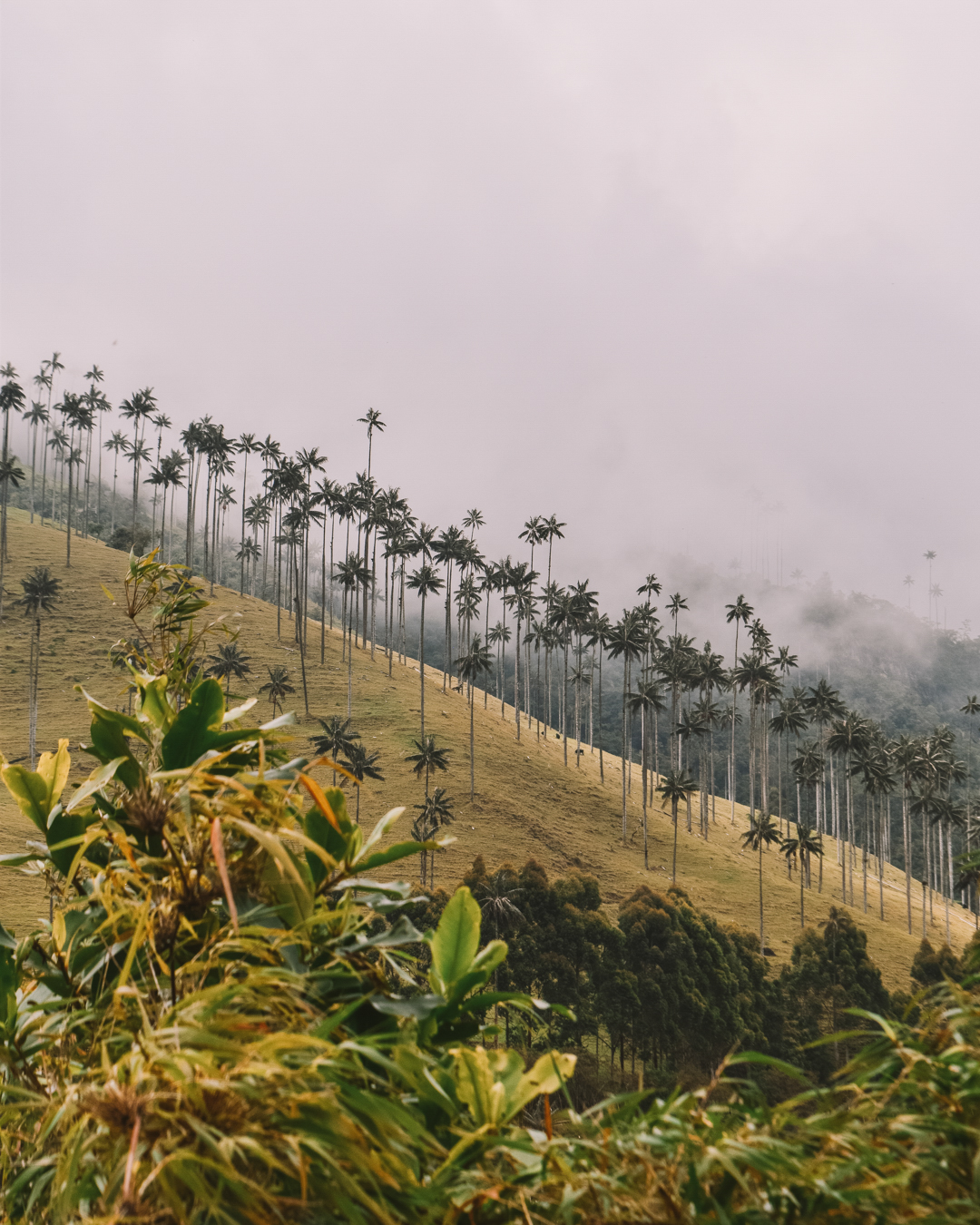

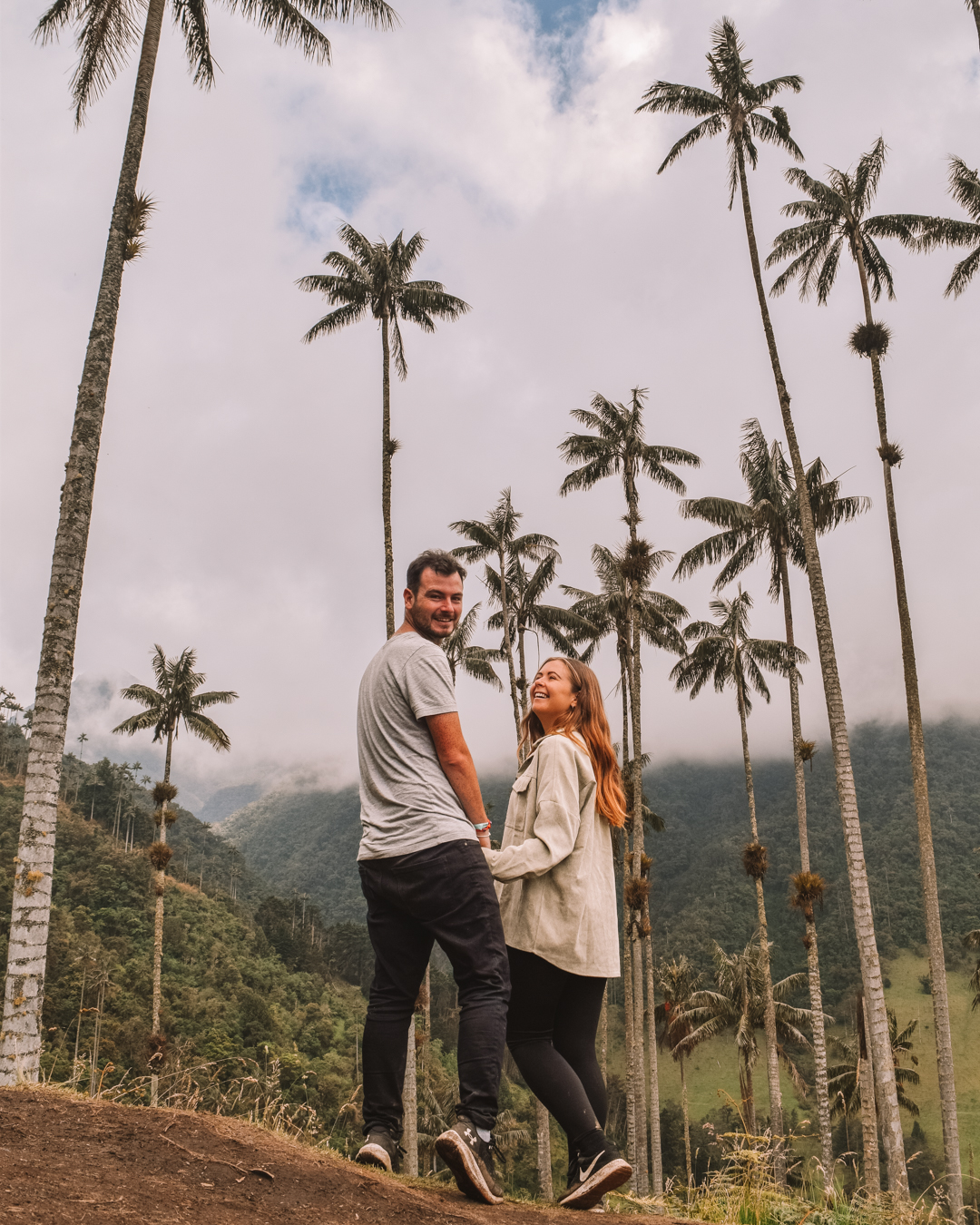
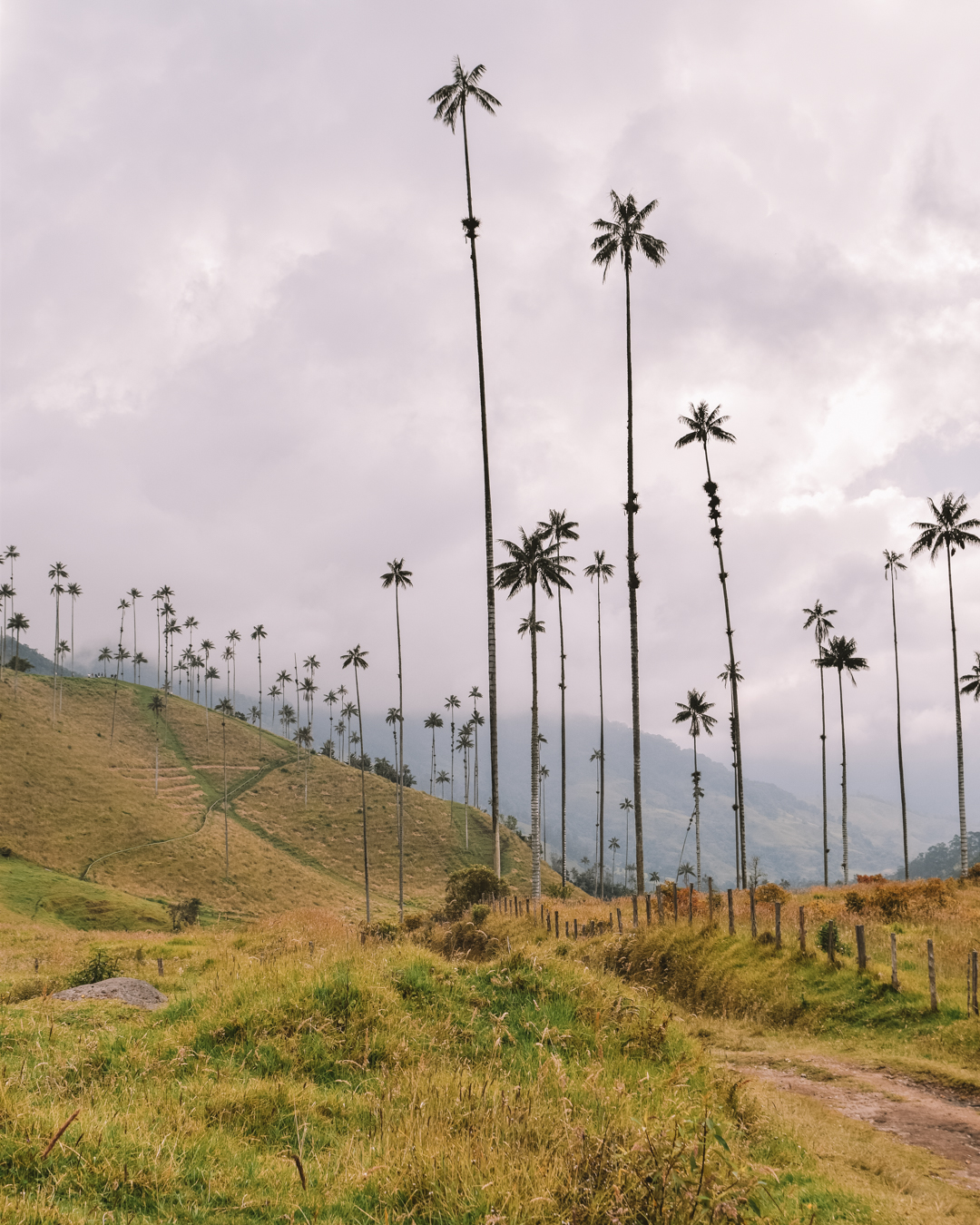
The town of Salento
The town is small, tiny in fact. But, it is well worth spending a day walking around it. Enjoy a little shopping for souvenirs or enjoy a cup of coffee at one of the cute cafes. If you visit before 9 AM, you’ll get to see the colourful doorways. After this time, the doors open to show the shops.
Once you reach the end of the street head up the stairs to Mirador de Salento to see beautiful views over the town.
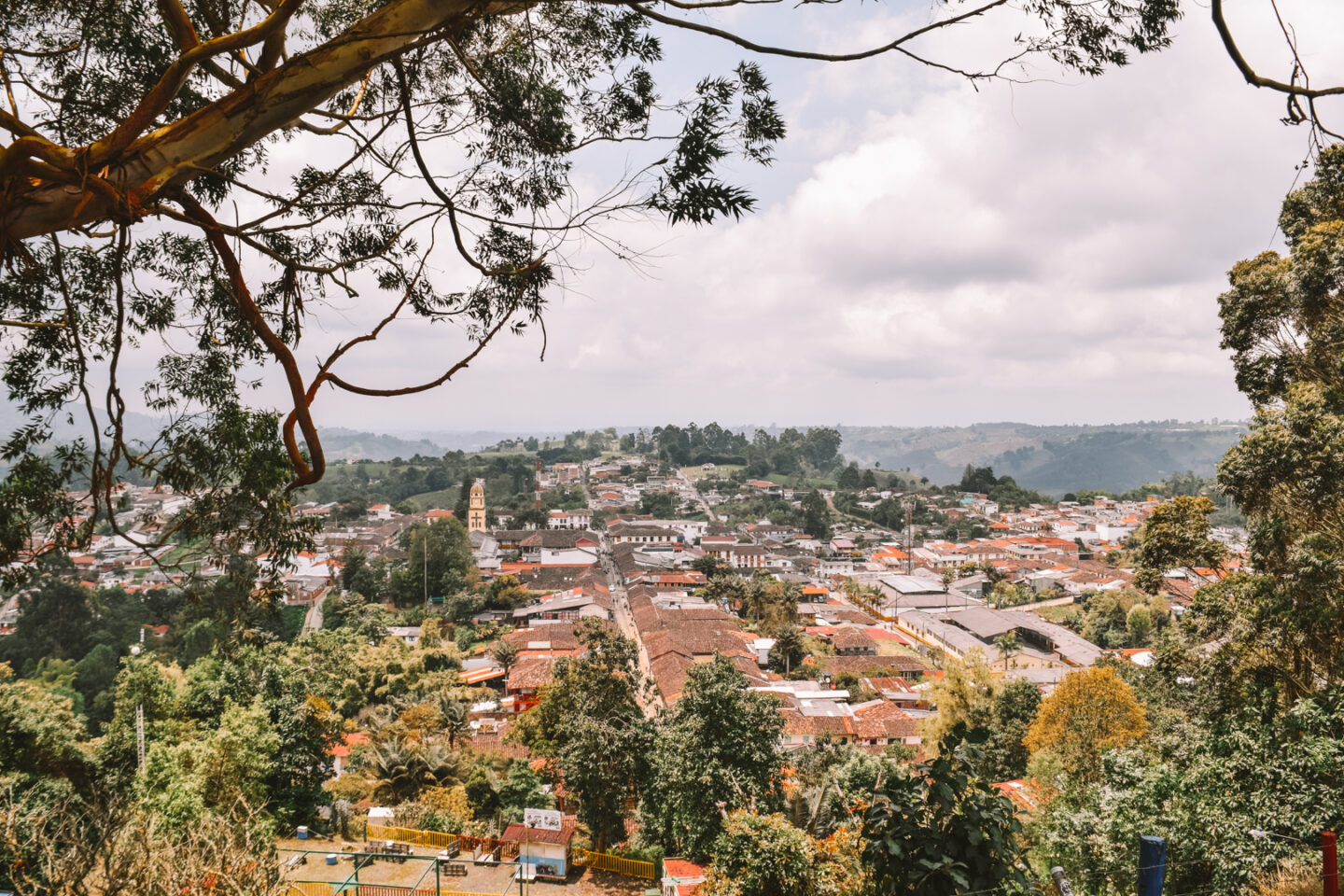
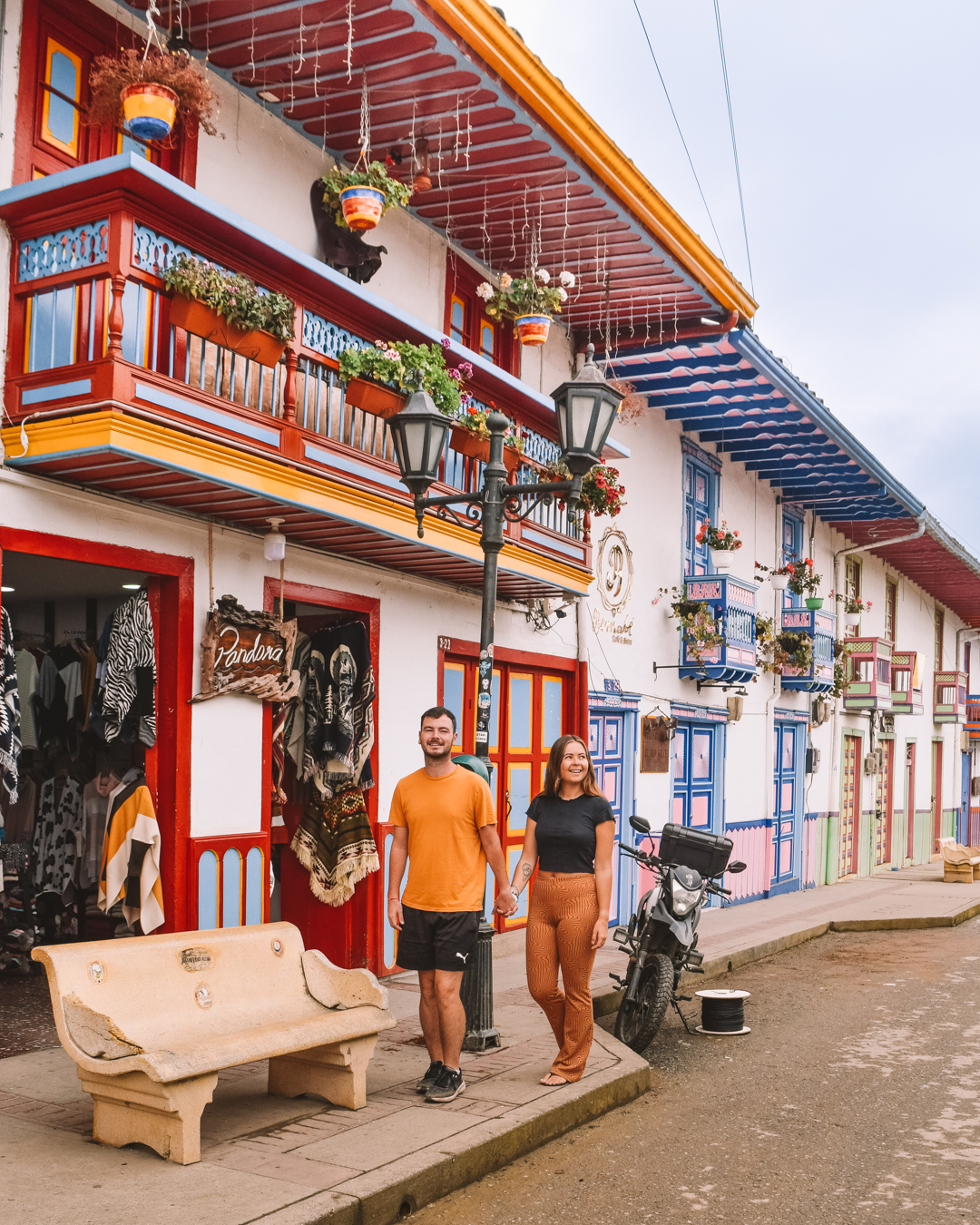
Where did we stay in Salento?
Despite it being a small town there are plenty of options to stay when visiting Salento. You first need to decide if you want to stay within the town or up in the hills surrounding it. Both have pros and cons and for us, it really came down to what our priorities were and this was seeing the palm trees and experiencing the town.
Soa Hostel
Due to the above, we opted to stay in Soa Hostel. It’s right on the main street so it was the perfect location for us. It definitely wasn’t the most luxurious place that we have ever stayed. However, it was cheap, in a great location and had a lovely little chill-out spot so suited us perfectly. Privates cost £25 and a dorm bed costs £7 per night.
You can book a stay in Soa Hostel here.
Coffee Tree Hostel
If you are looking for something a bit more luxurious (but, still budget-friendly) with incredible views then Coffee Tree Hostel is the one for you. Prices vary from £46 for a private and £12 for a dorm room.
You can book a stay in Coffee Tree Hostel here.
Planning a visit to Salento? You can read our full blog post on the colourful town here.
Cali
Founded in 1536, Cali is one of South America’s oldest cities. Now Columbia’s third largest city, Cali is still struggling from its Narco days and isn’t as popular as Medellín or Bogotá. However, you’ll find a lot of people visit the city for one reason: salsa.
What are the top things to see in Cali?
There are plenty of streets to explore, cafes to sip coffee from and trails to walk on in Cali. Here are our top things to see when visiting Cali:
- Attend a salsa class
- Take a street food tour
- Take in the street art
- Wander San Antonio; commonly referred to as “Old Cali”
Travelling to Colombia
Where did we stay in Cali?
As with all large cities in Colombia, Cali is no different and has a large range of hostels and hotels dotted throughout it, all for a very reasonable price.
We opted to stay at ON Hotel Cali which we recommend. We had a private room with an en-suite, lounge and kitchen area all for the cost of £31 per night including a cooked breakfast delivered to your room
Don’t you just love South America?!
Ipiales
Ipiales is a small city on the border of Ecuador. It’s a great spot that’s well worth a visit if you’re crossing the border between Colombia and Ecuador. The main (and only) attraction of this small border city is a visit to the beautiful Las Lajas church.
Travelling to Colombia? Don’t miss this little spot!
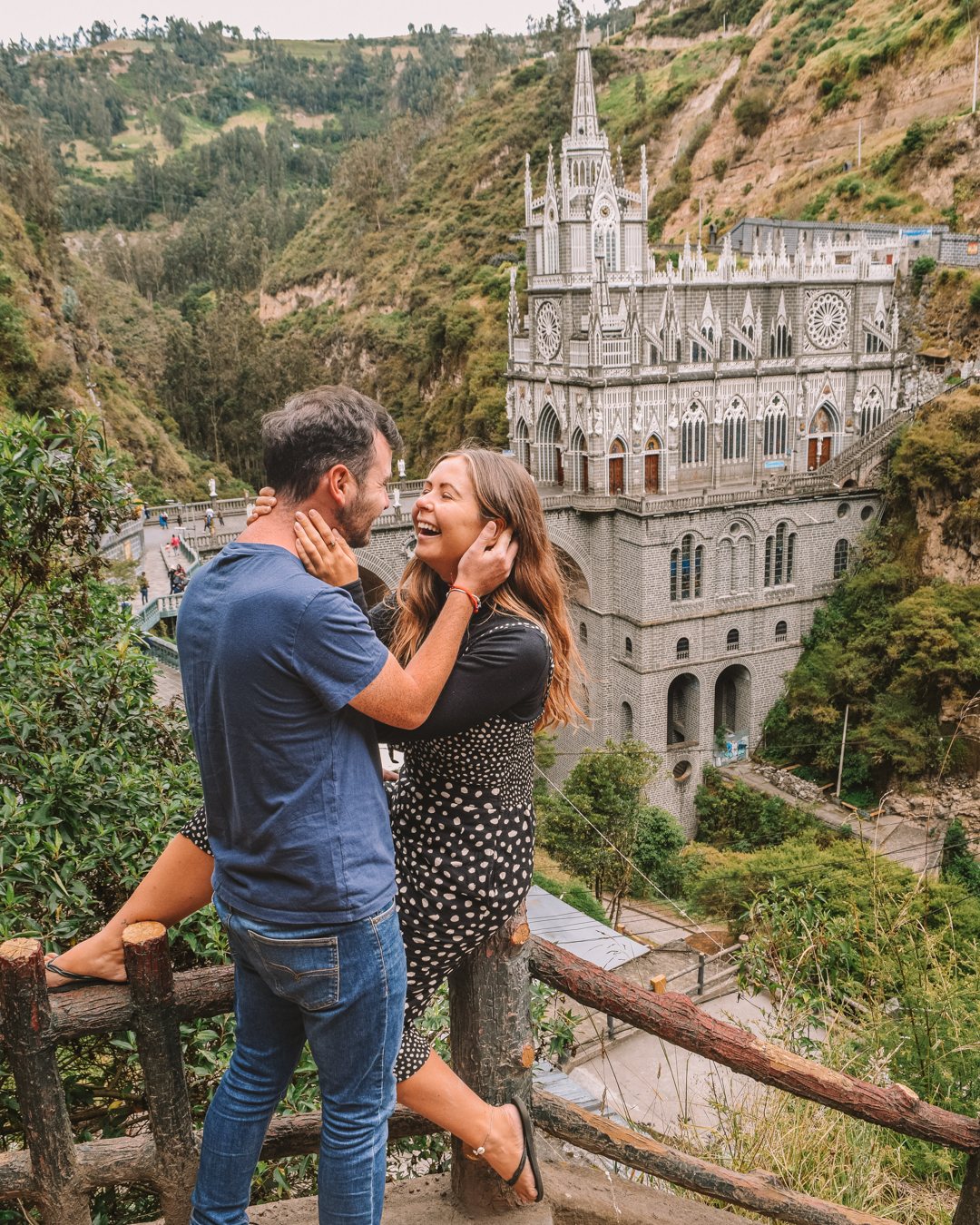
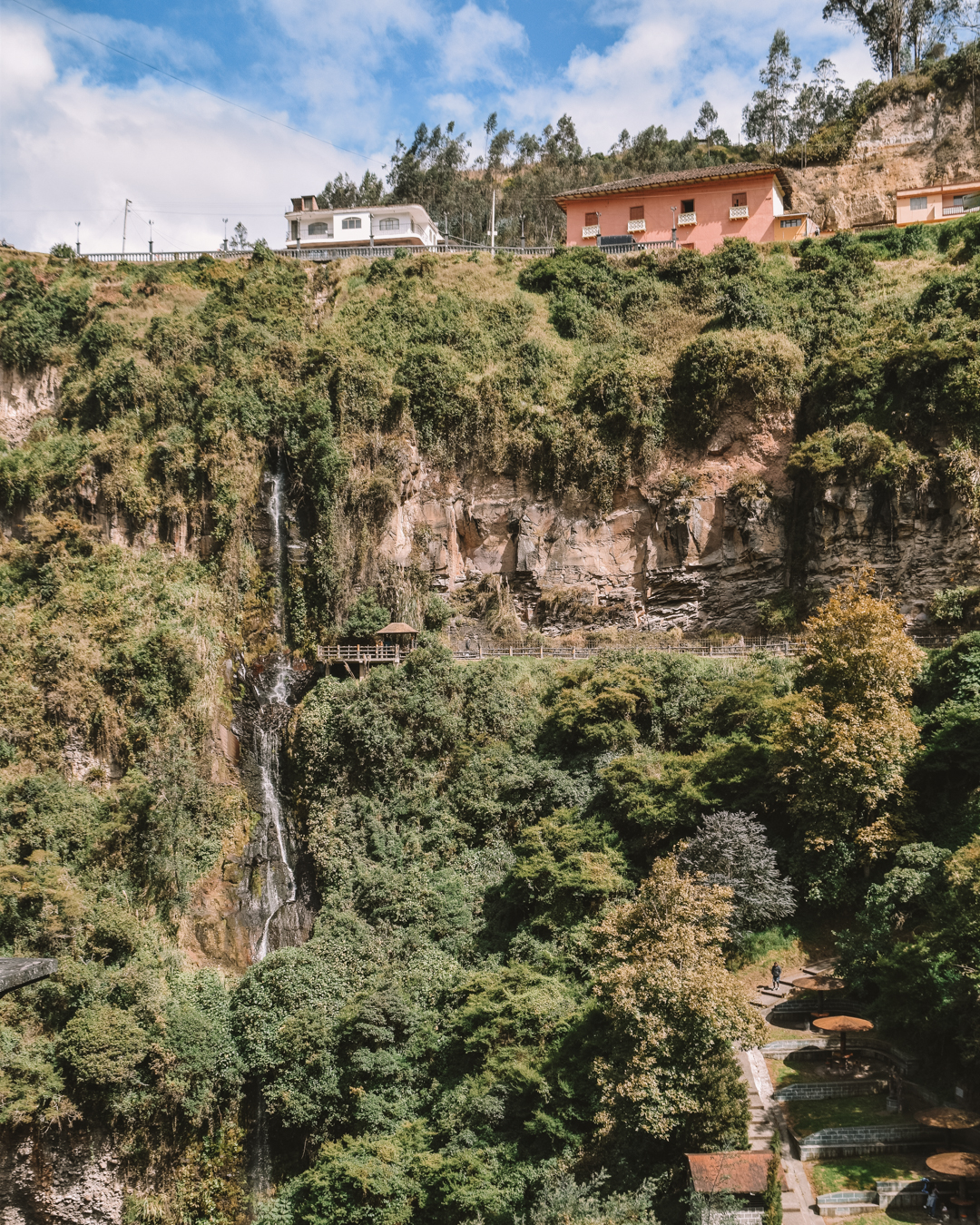
What are the top things to see in Ipiales?
Just a short 20-minute taxi ride away stands the most incredible church we have ever seen surrounded by waterfalls and lush green trees. Santuario De Las Lajas is an incredible Gothic-style church built inside the canyon of the Guáitara River.
Entrance is free and you can easily walk around the whole area meaning you just pay a small cost to get there and back in a taxi. We paid around 6000 COP for both of us each way (around £1.20). There aren’t tons of other things to see here but, if you’re planning on crossing the border then 1 night here is a great way to break up your journey between the two countries and see something incredible while you’re at it!
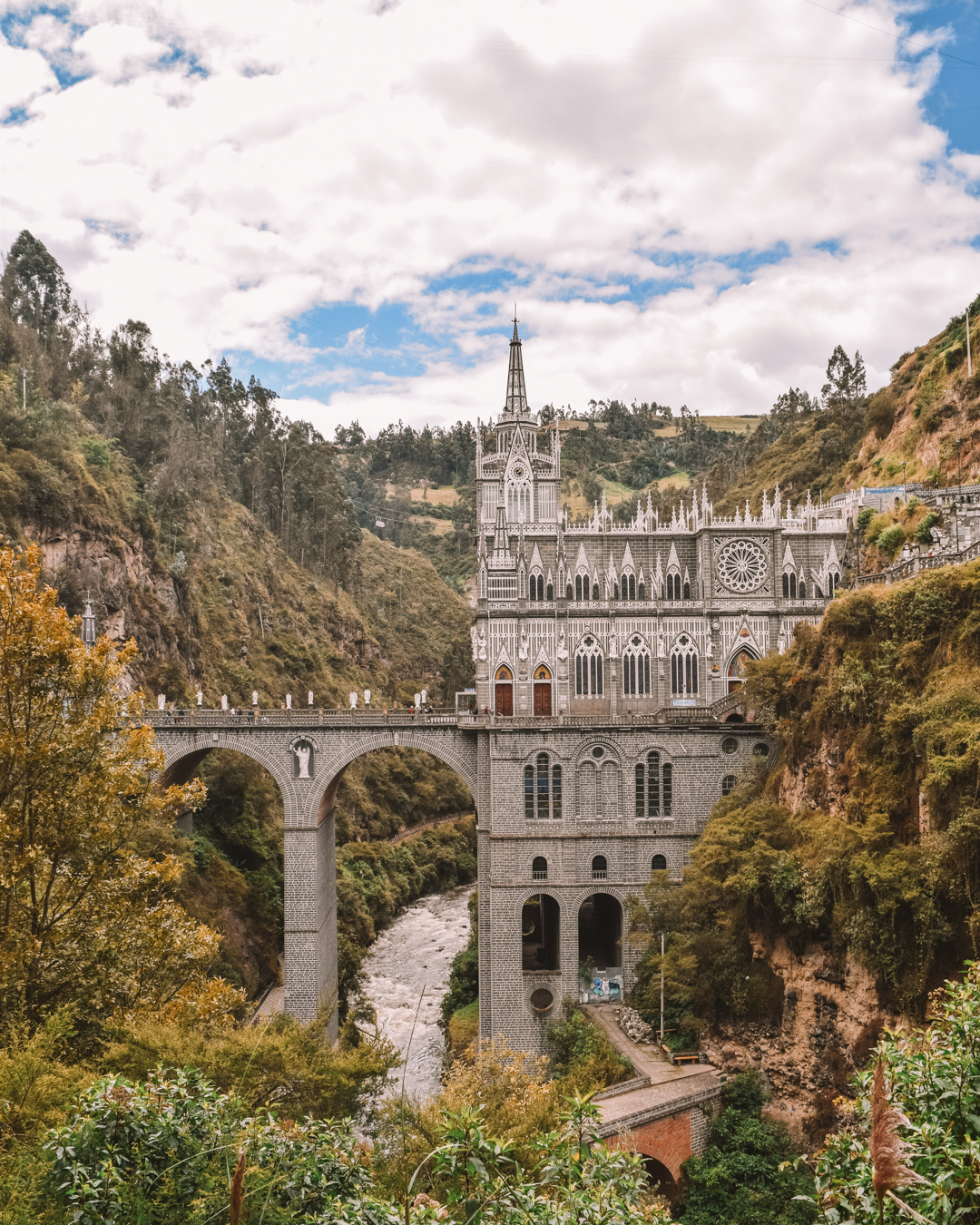
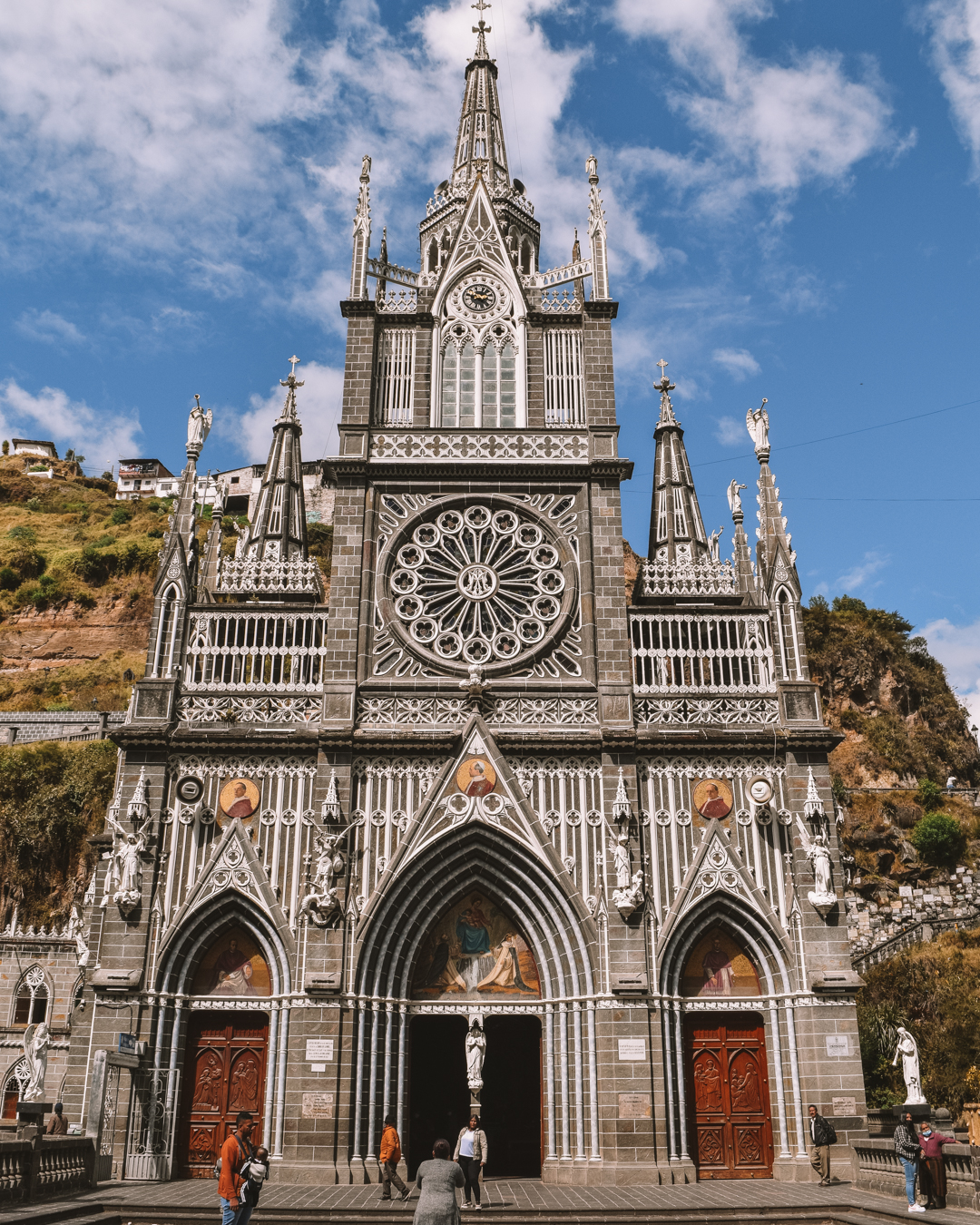
Where did we stay in Ipiales?
Unlike the large cities found in Colombia, the small border town of Ipiales has just one hostel. Xantico Hostal, luckily the hostel has great reviews, chill-out areas and most importantly (for us anyway) curtains on each of the bunk beds. Costing just £6 per bed it’s also very reasonably priced.
If you prefer a private room or something a bit more luxurious then Loft Hotel Ipiales is for you. A beautiful room for just £40 per night.
So, there you have it! Our ultimate guide to travelling to Colombia. We hope that you’ve found it useful and that you have just as an incredible time when you travel Colombia as we did. Any questions or comments please let us know below!
